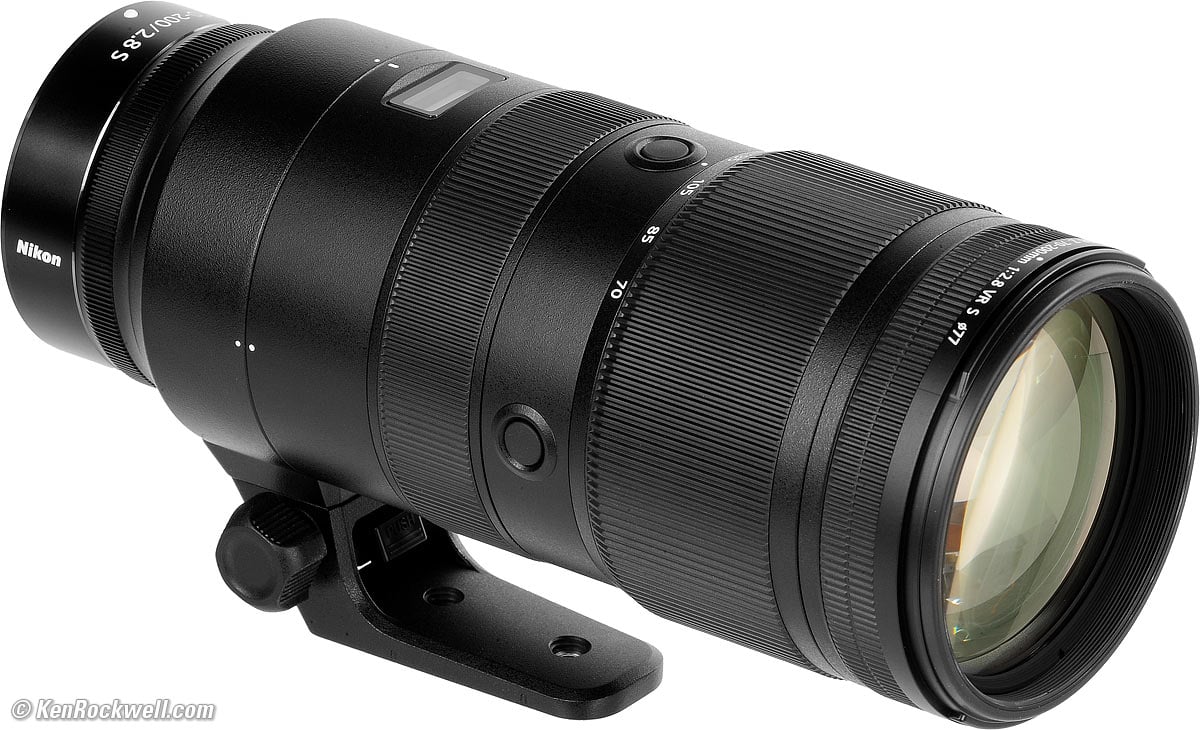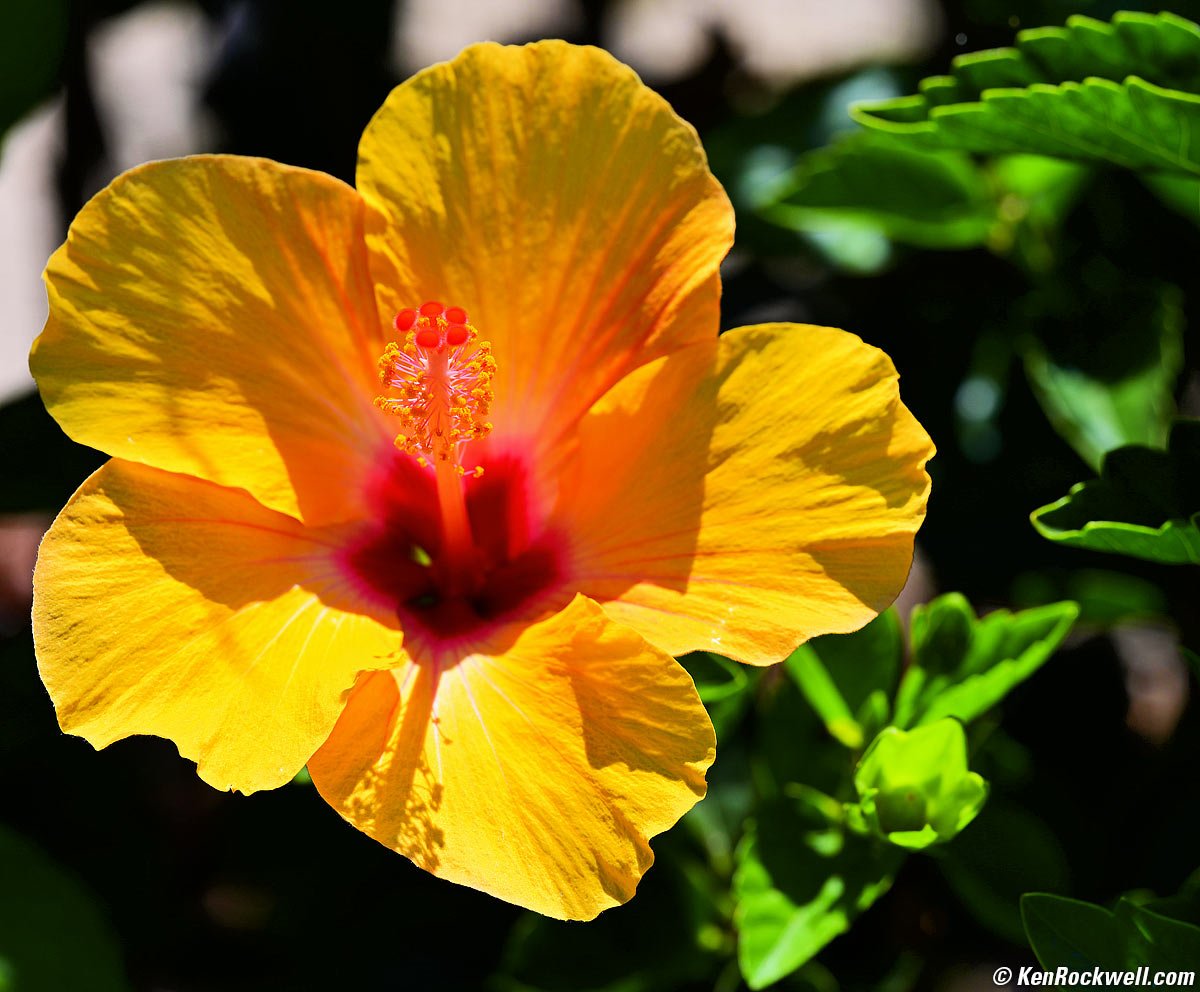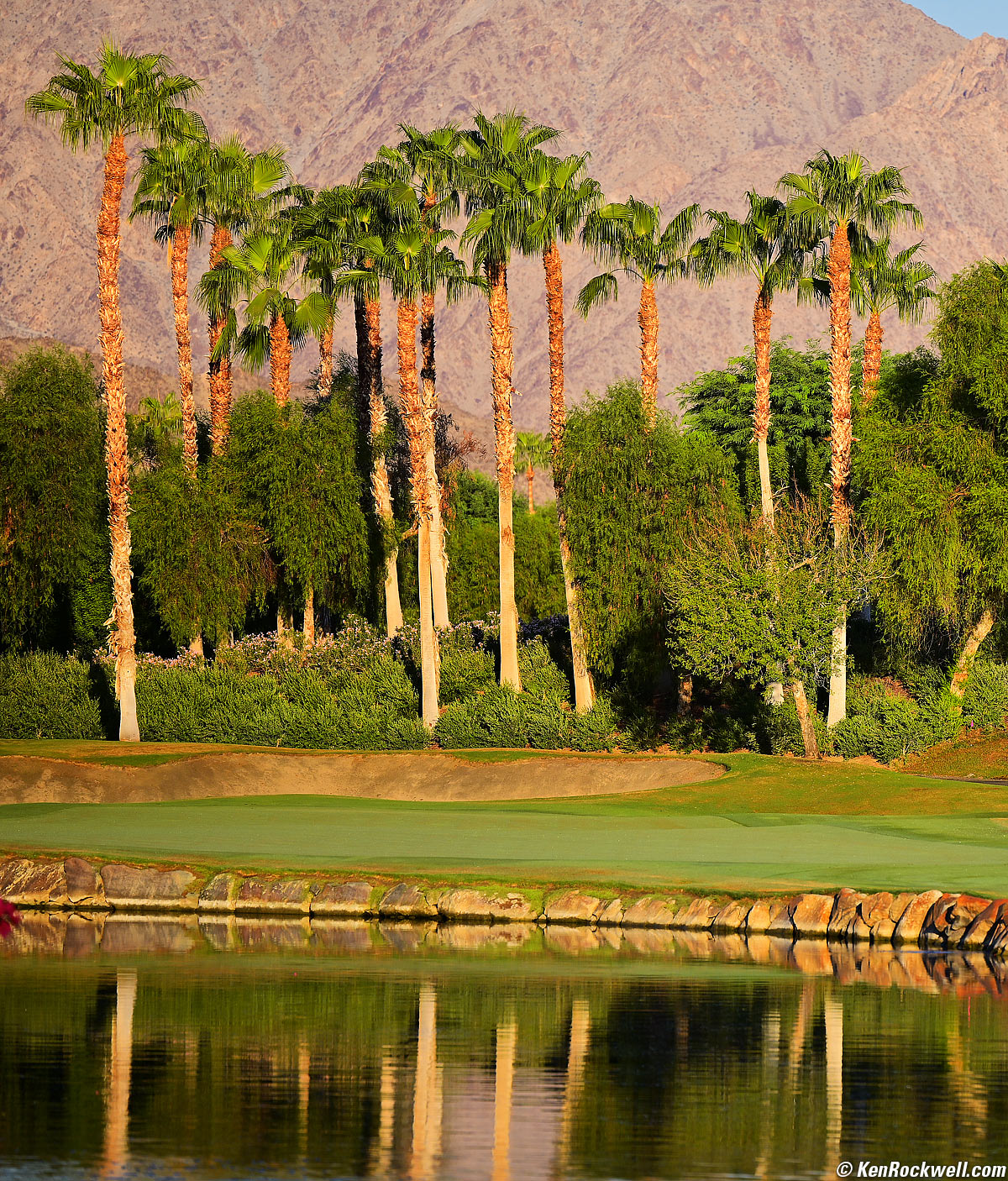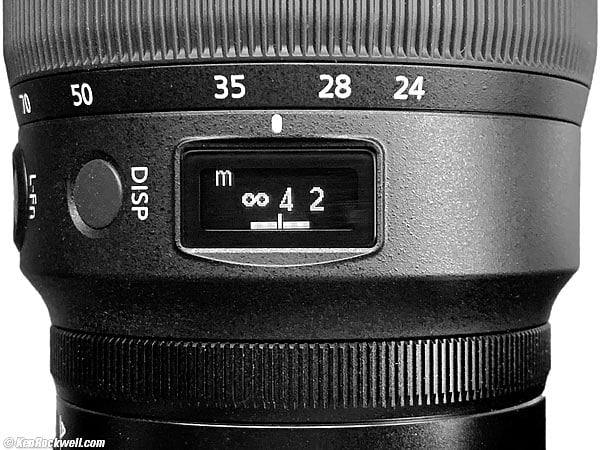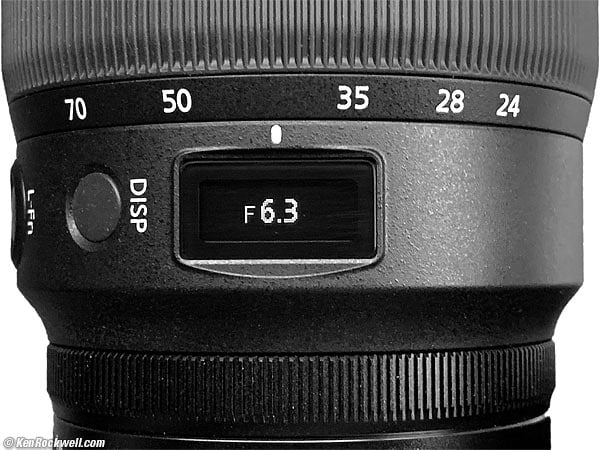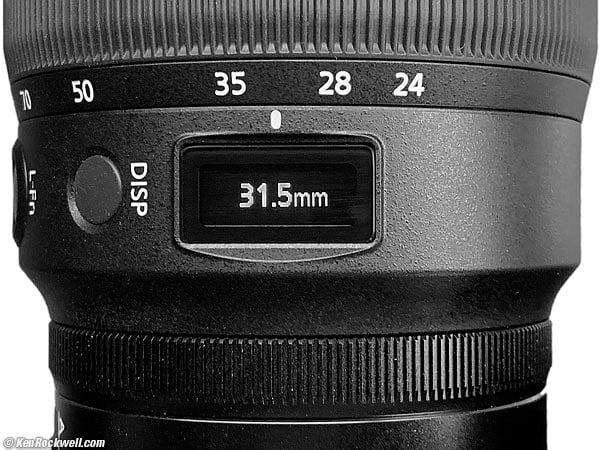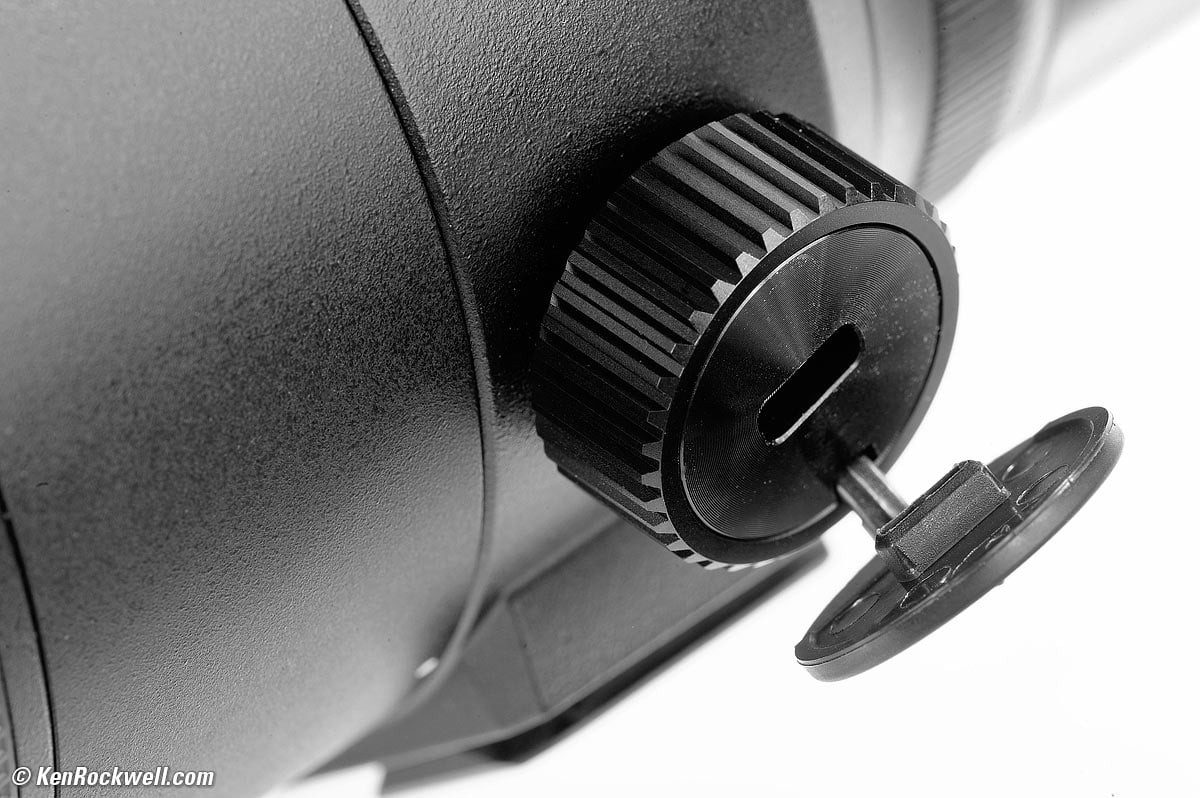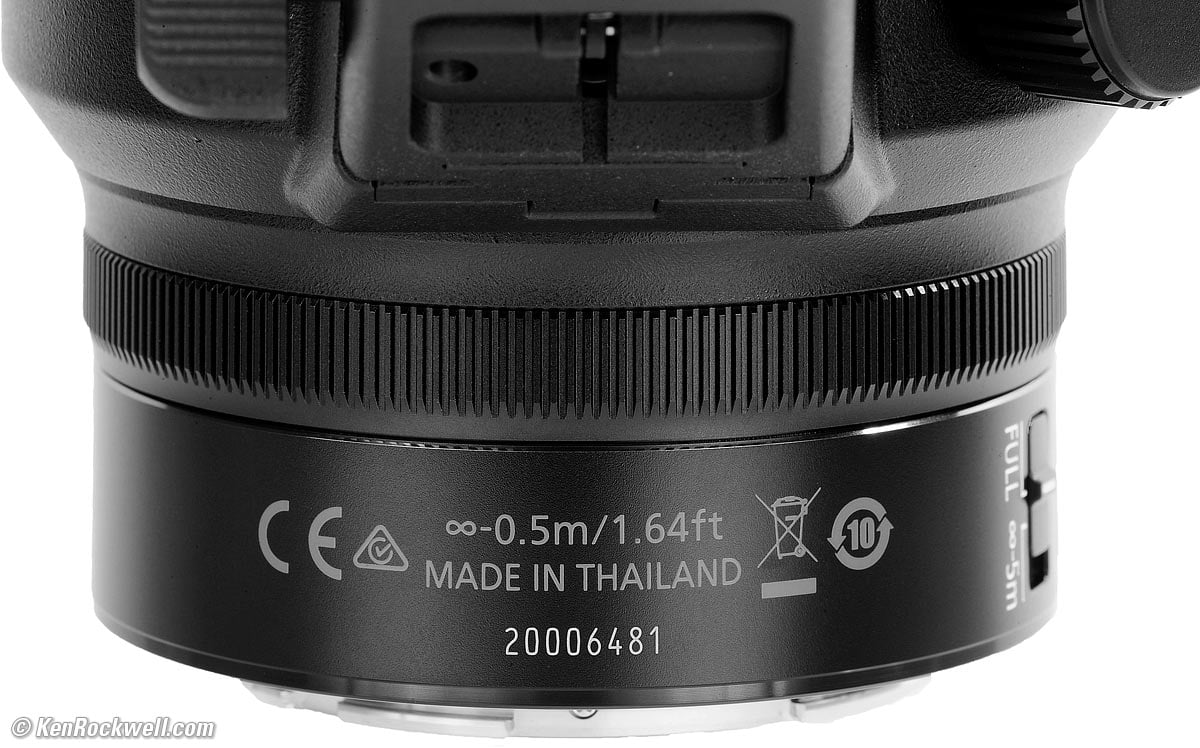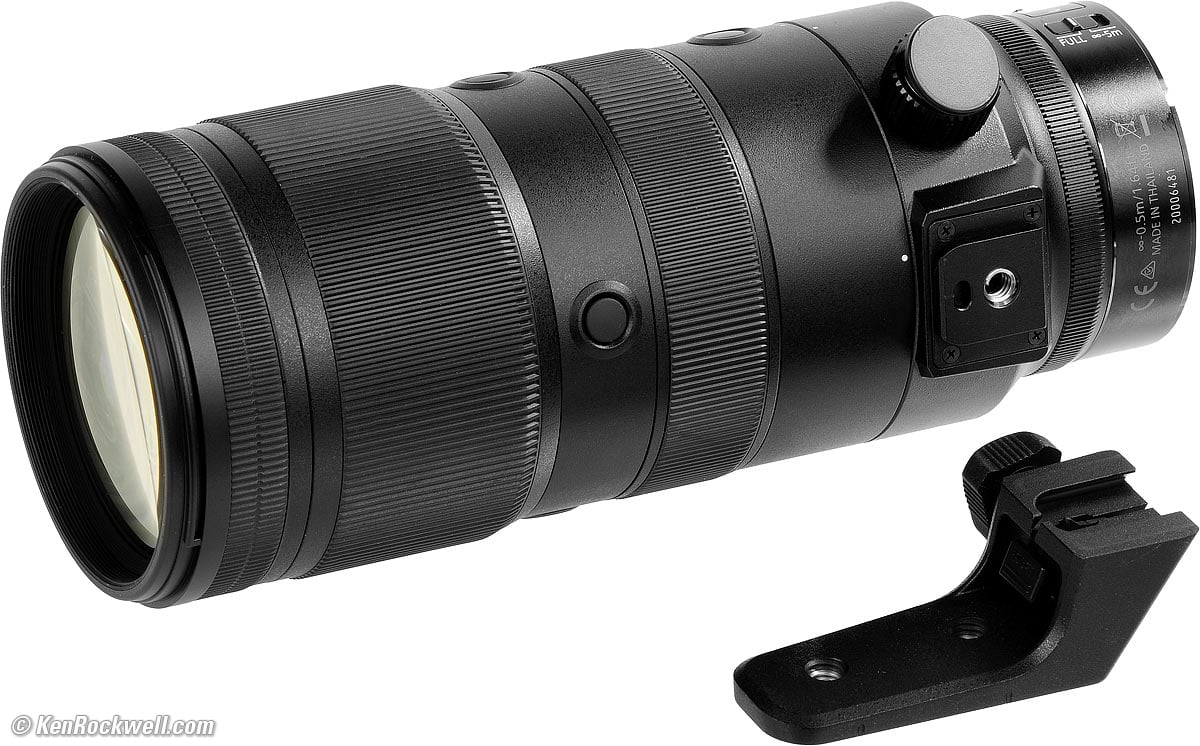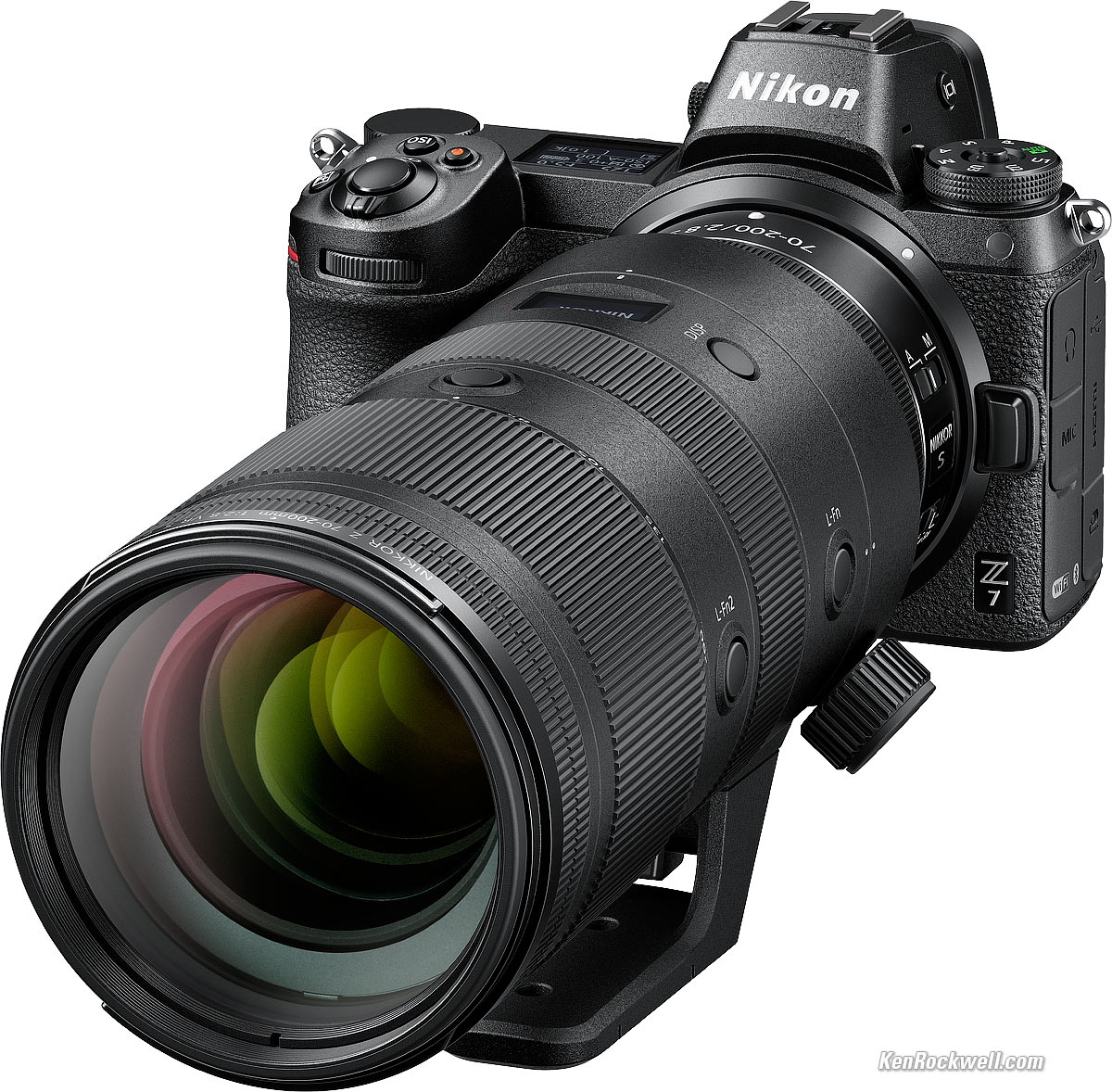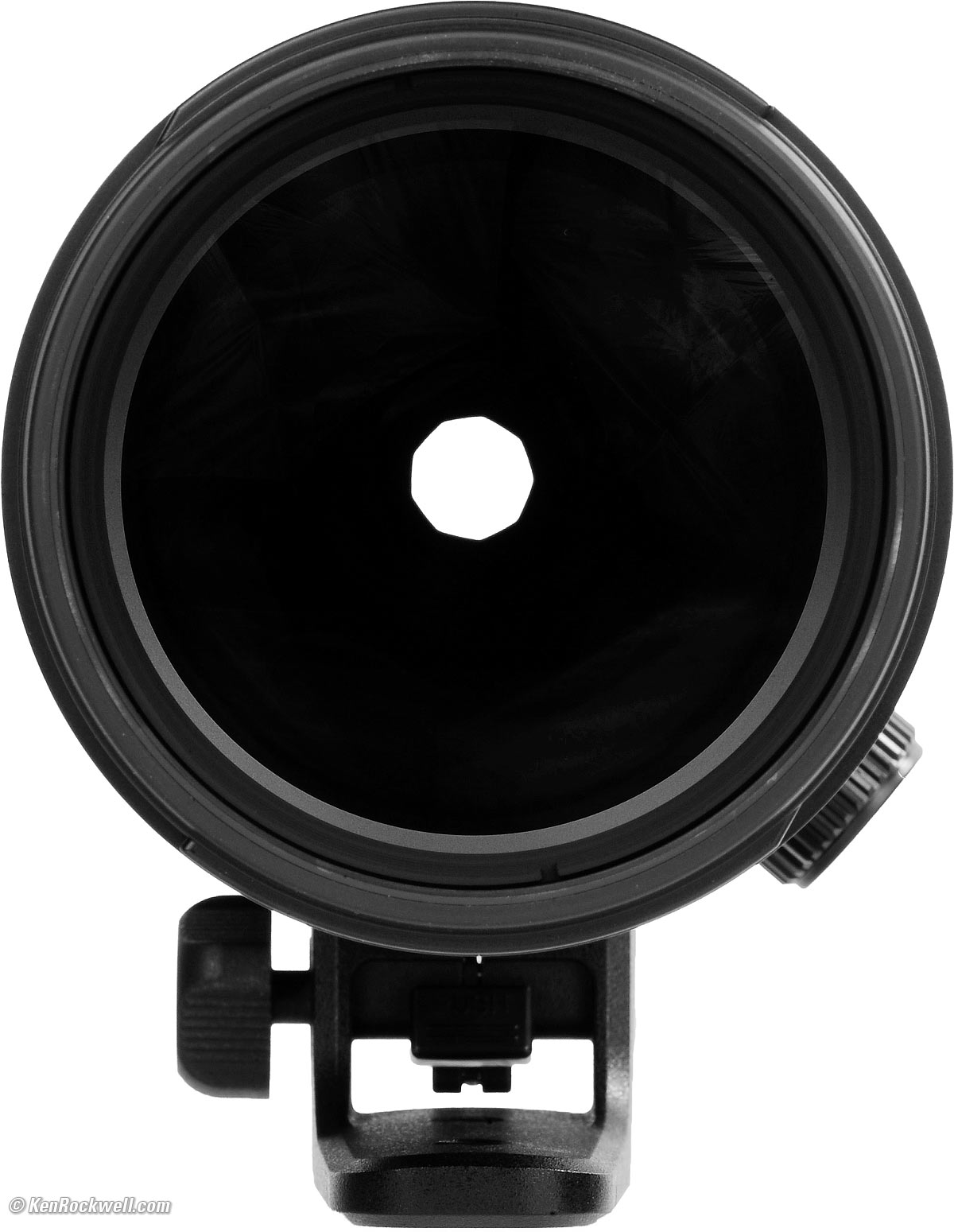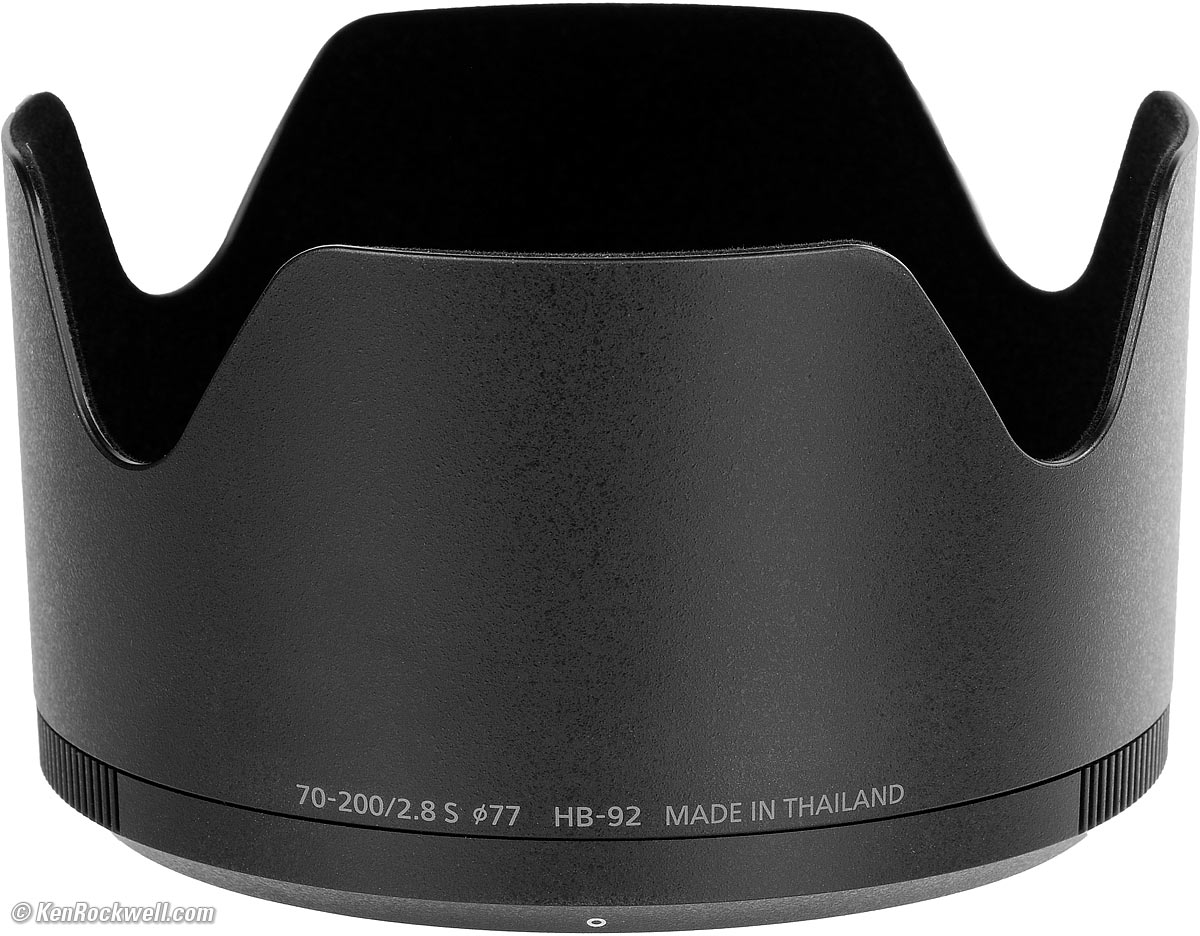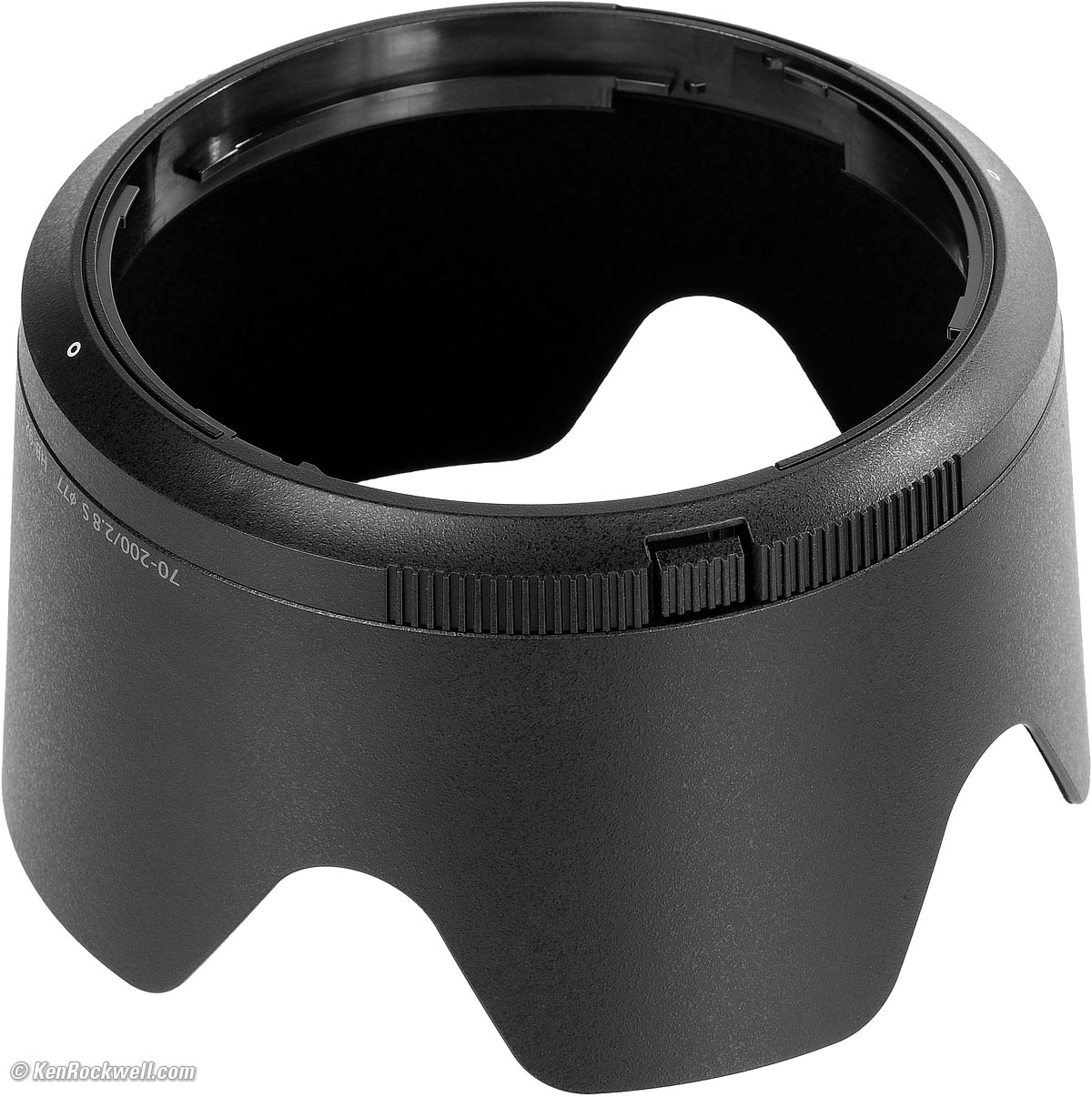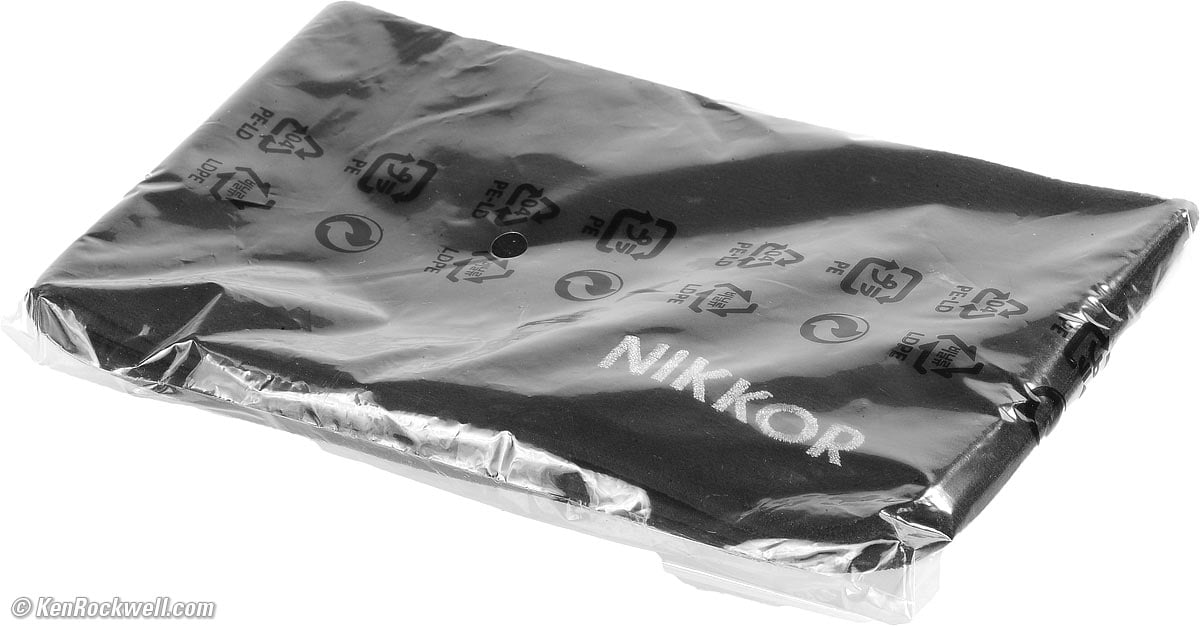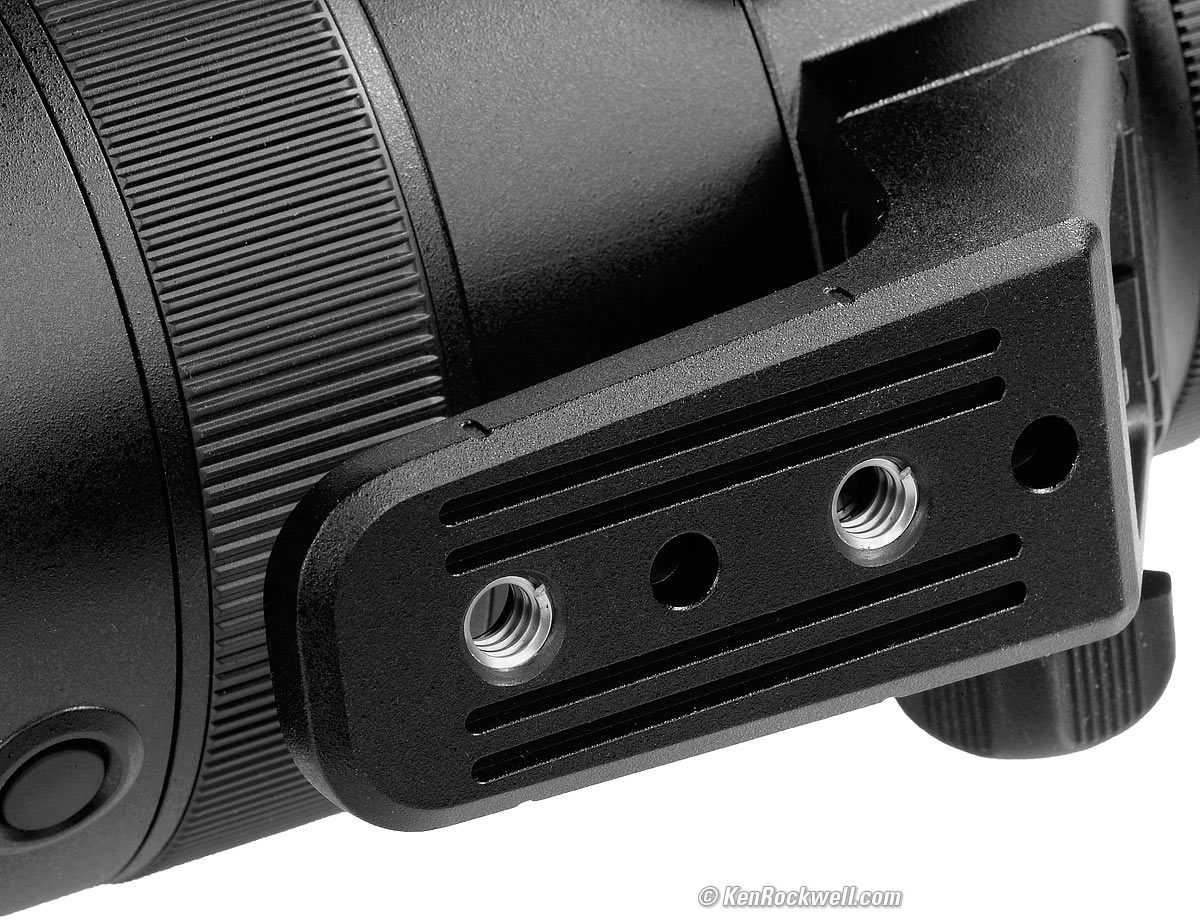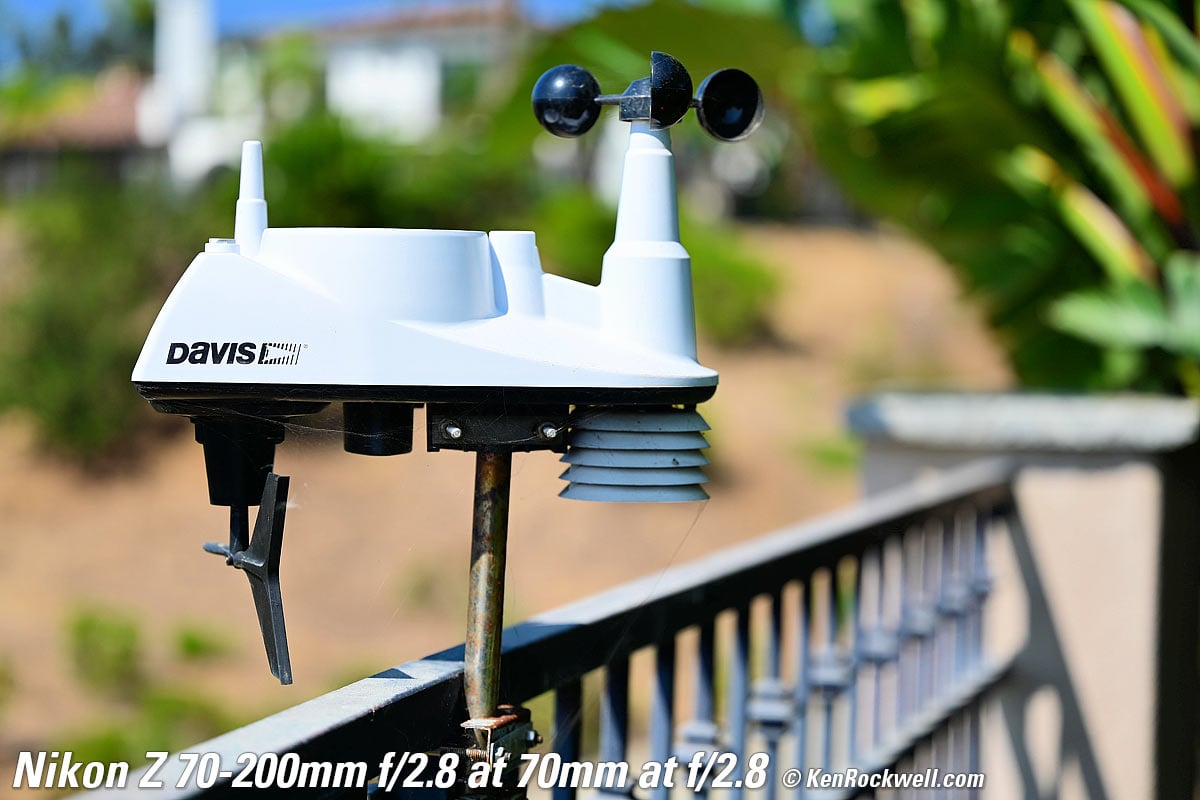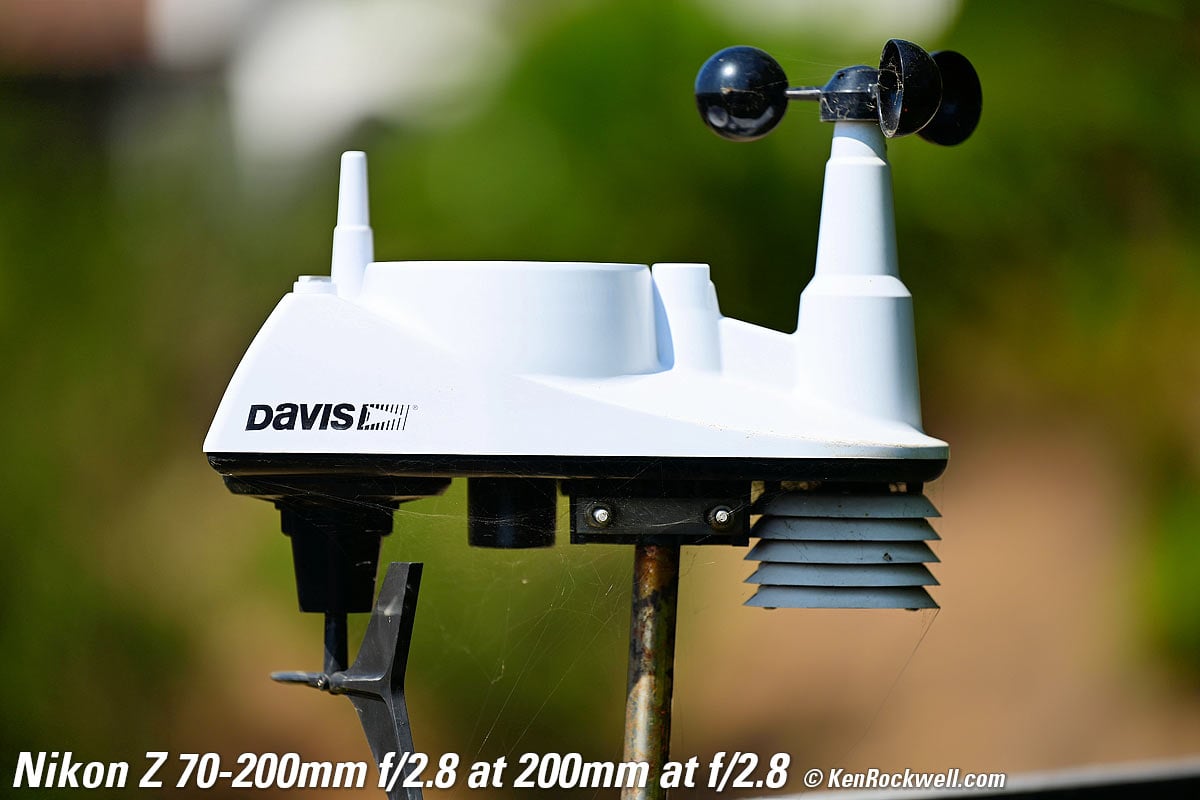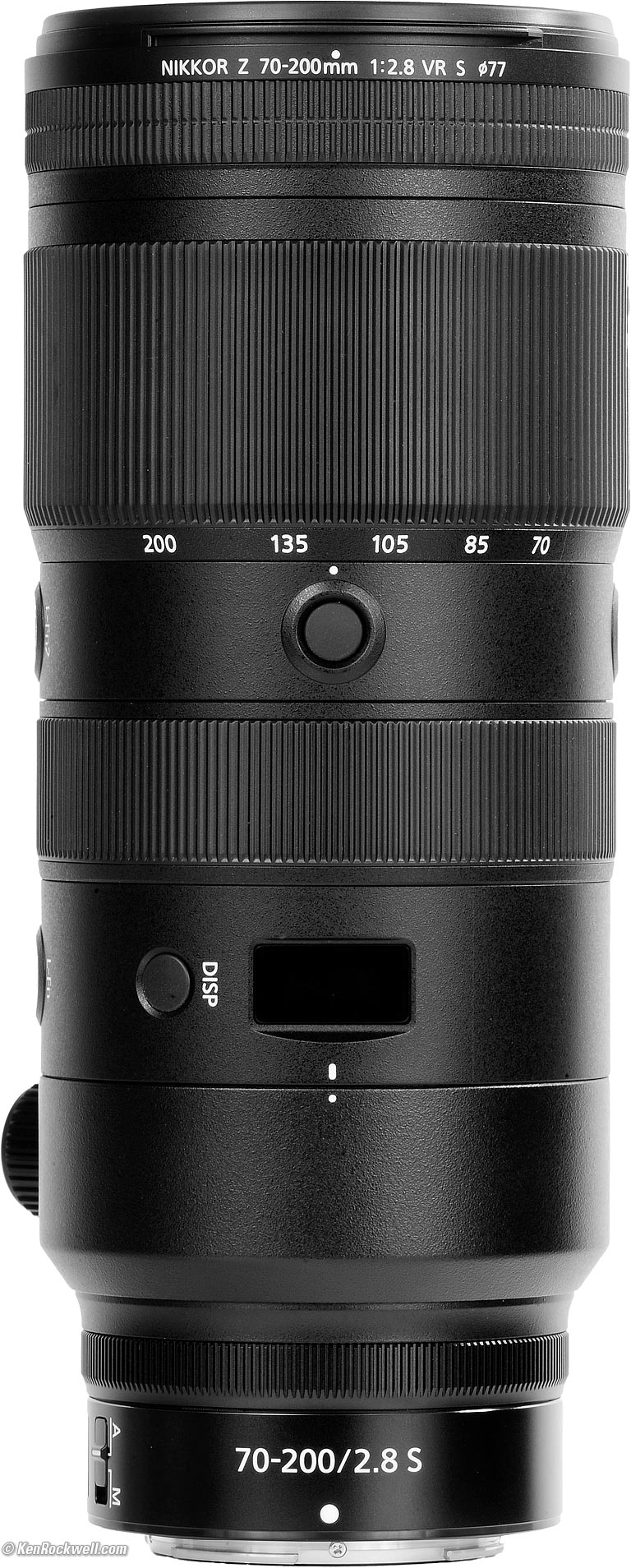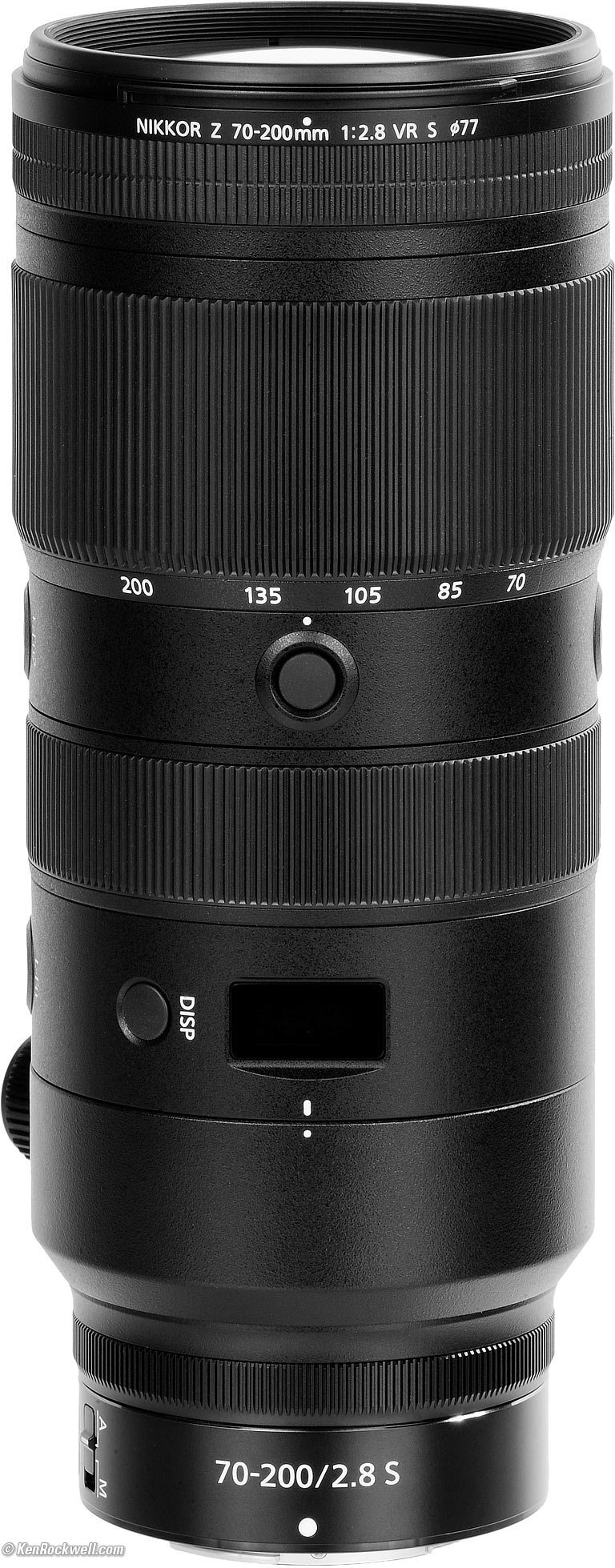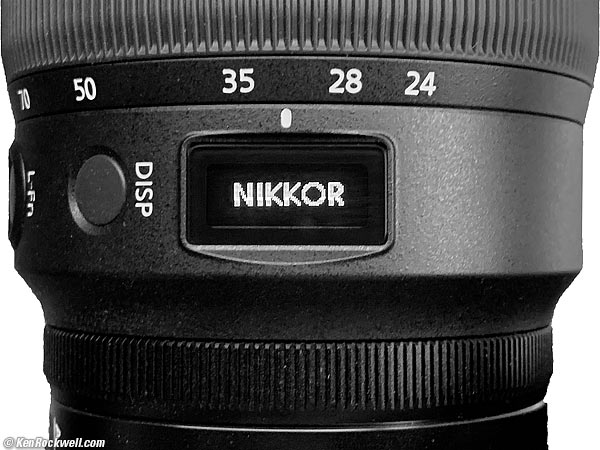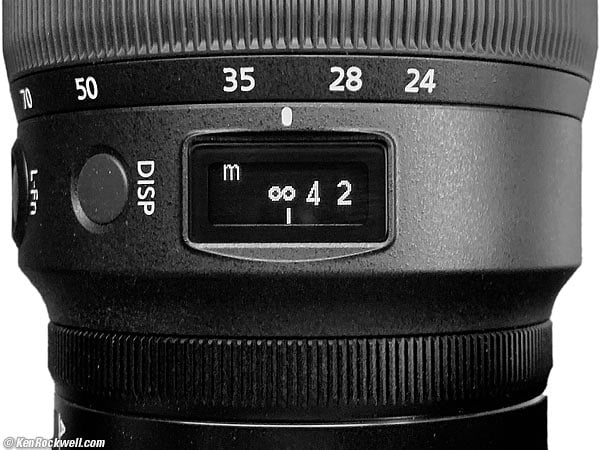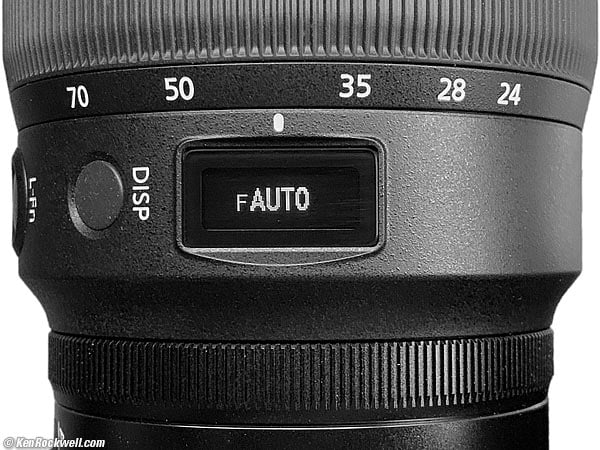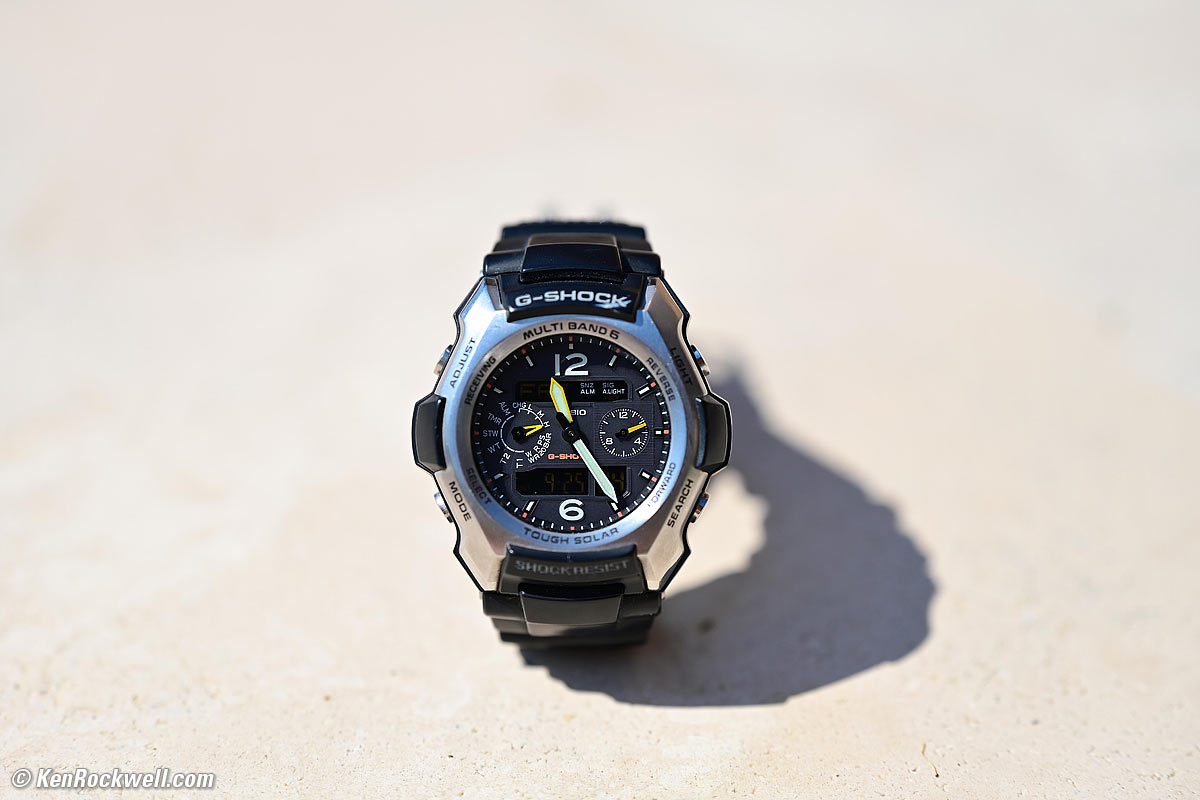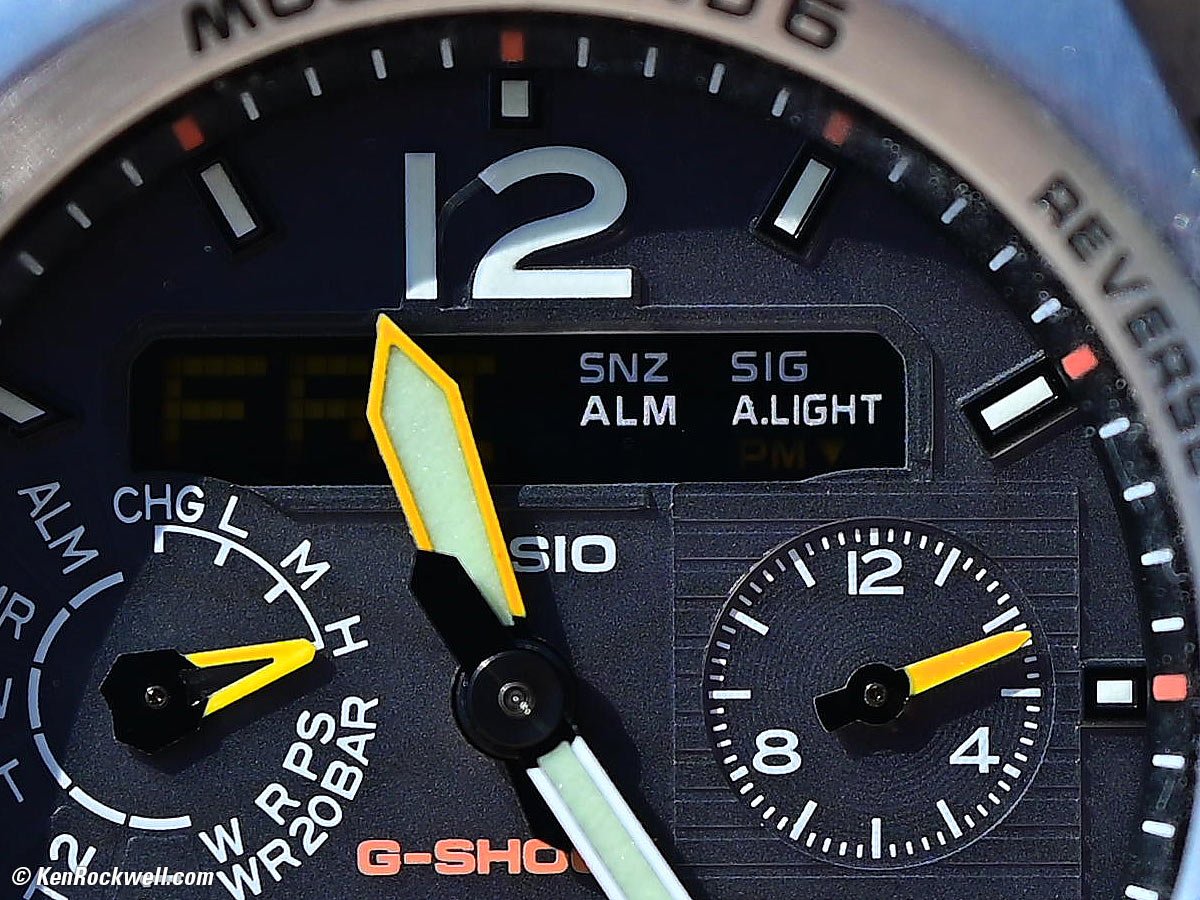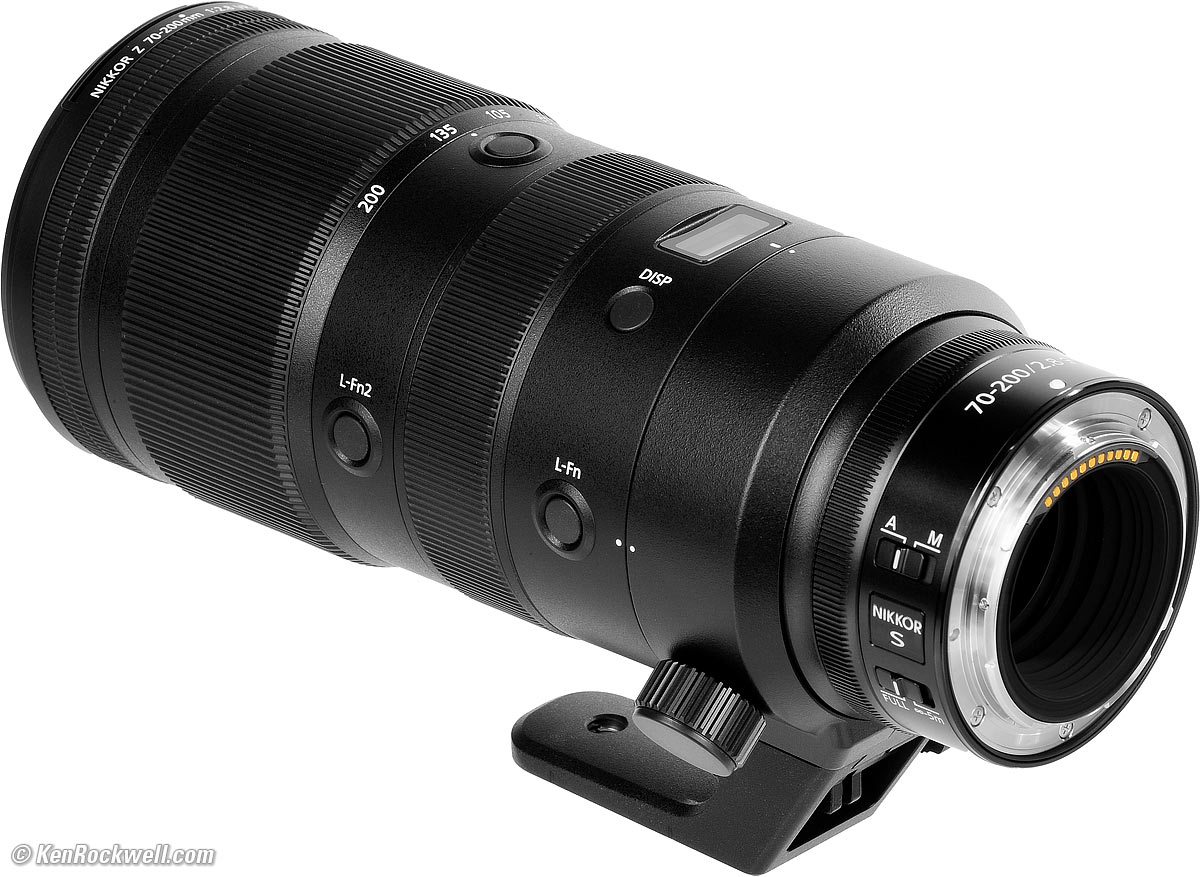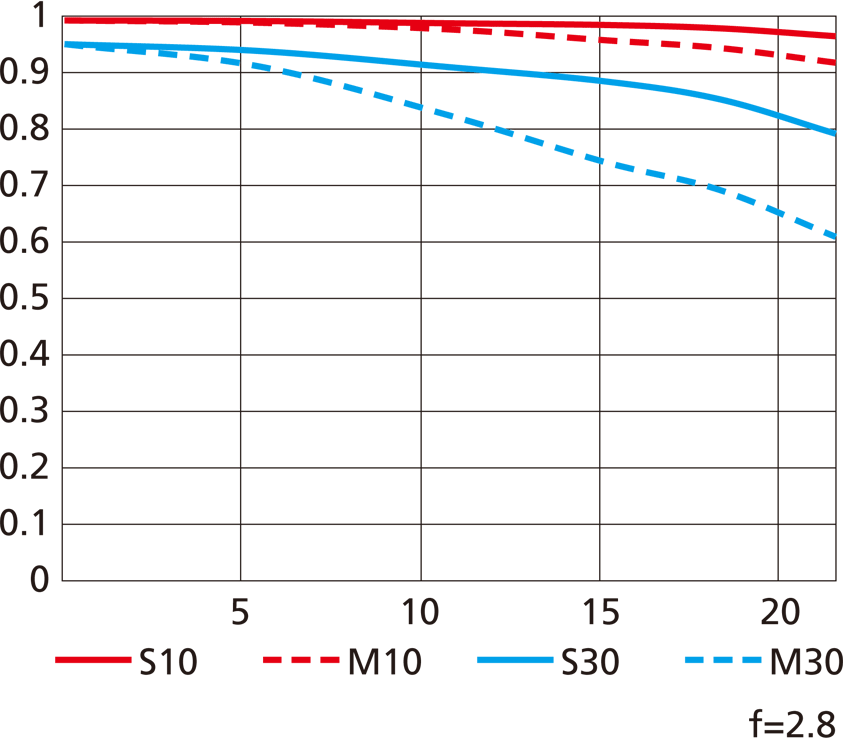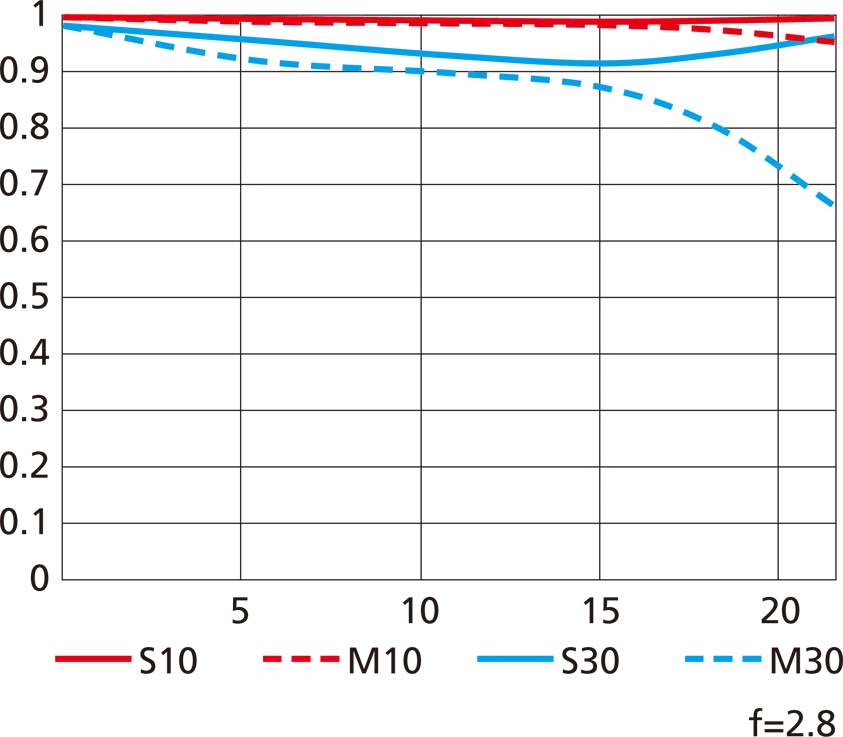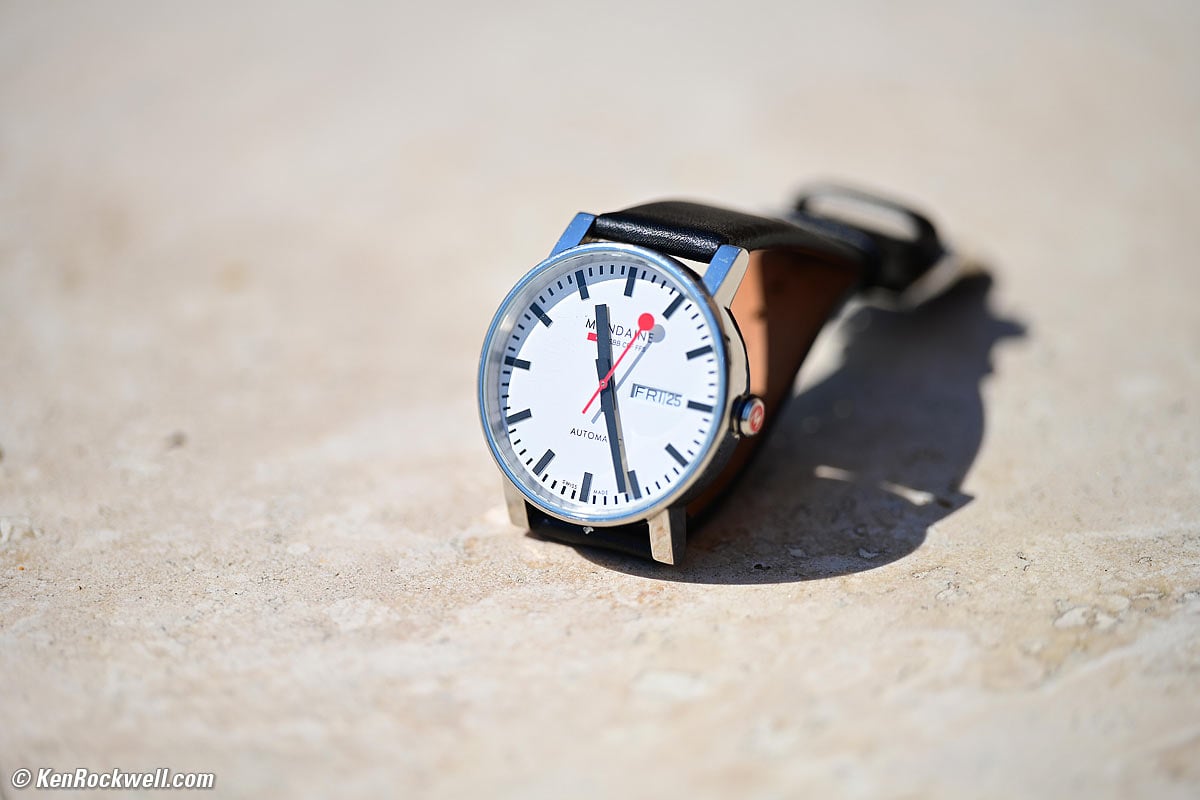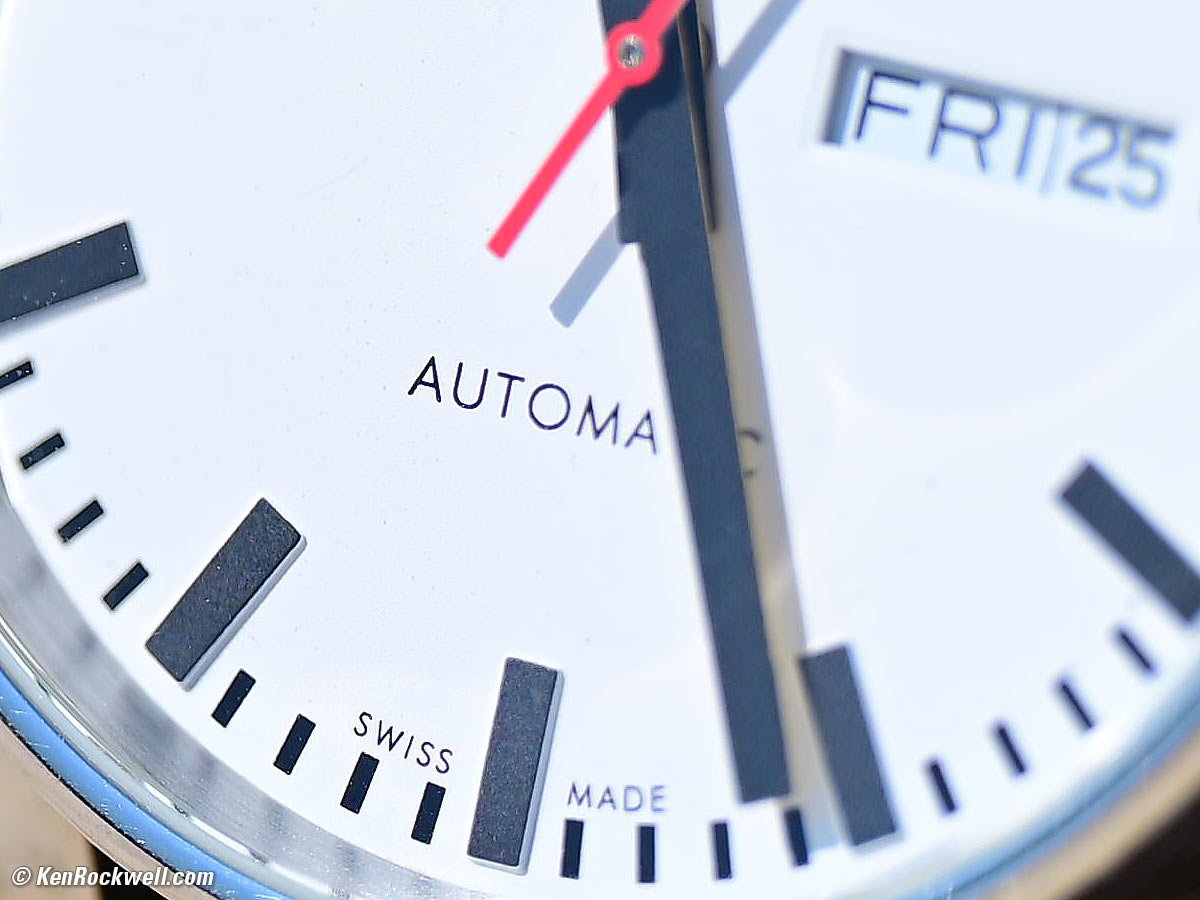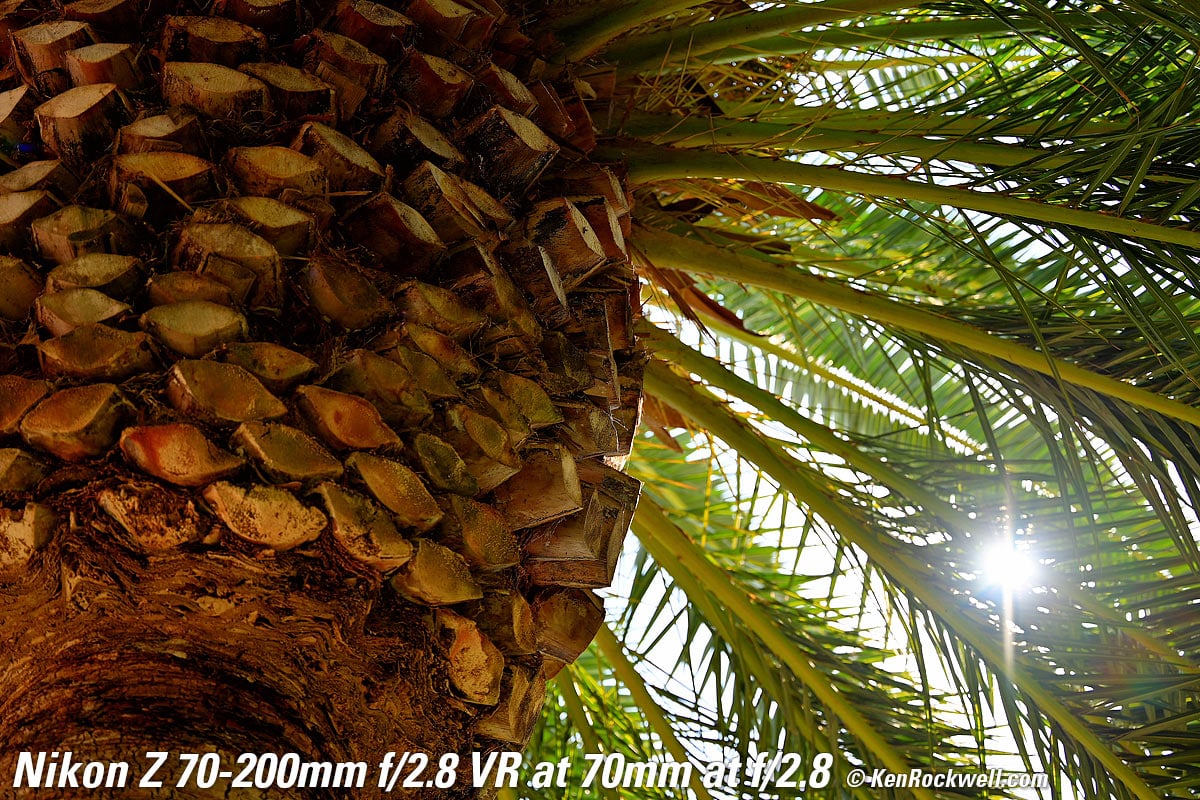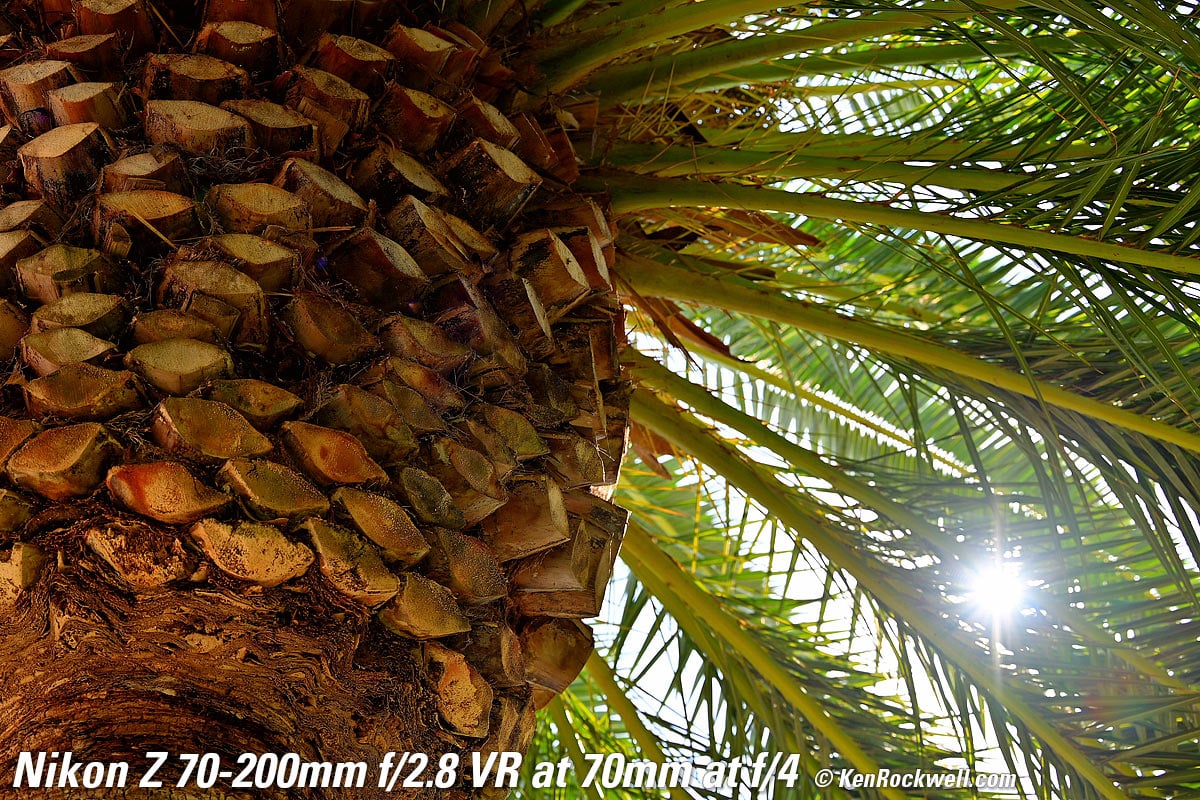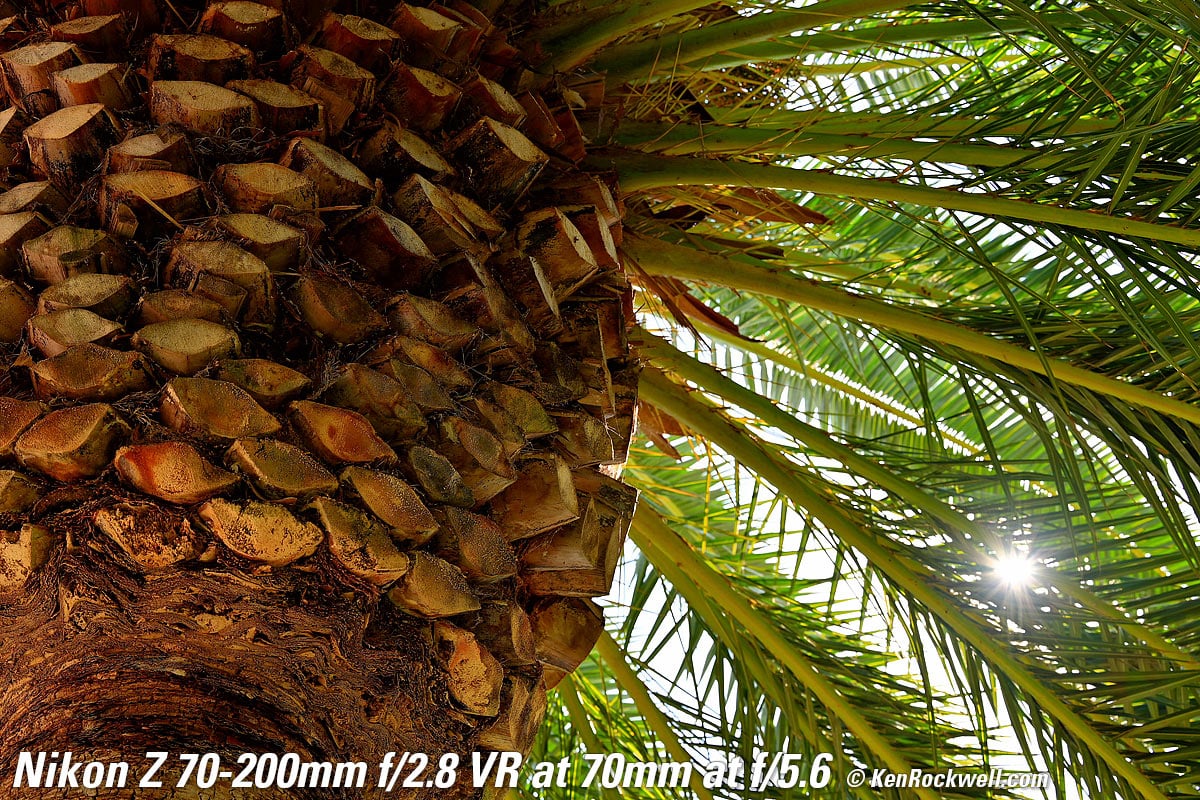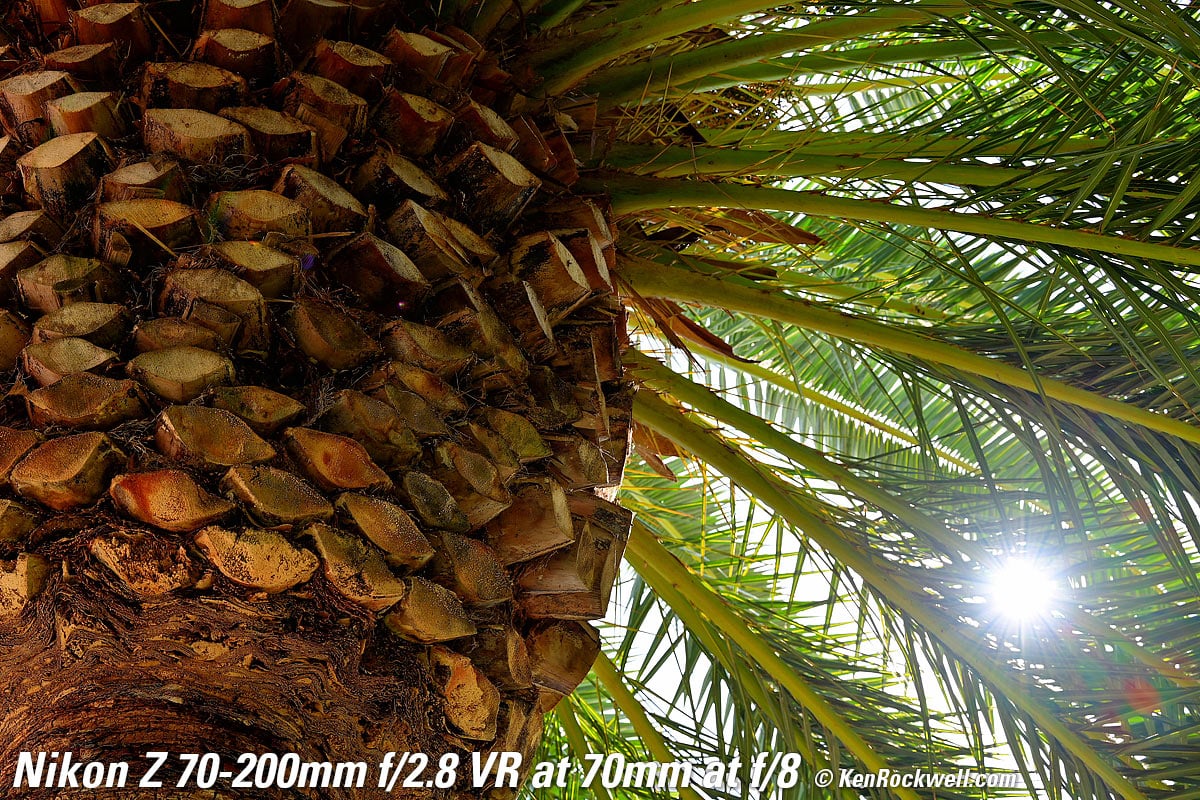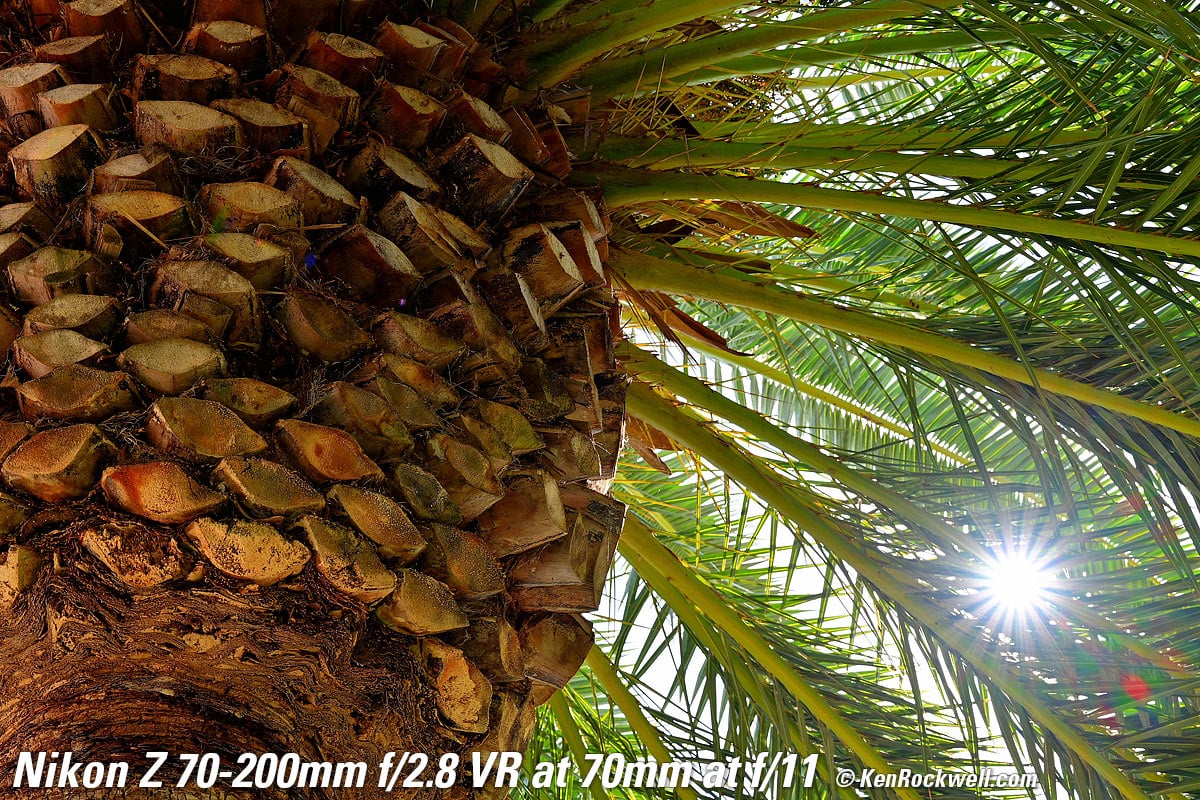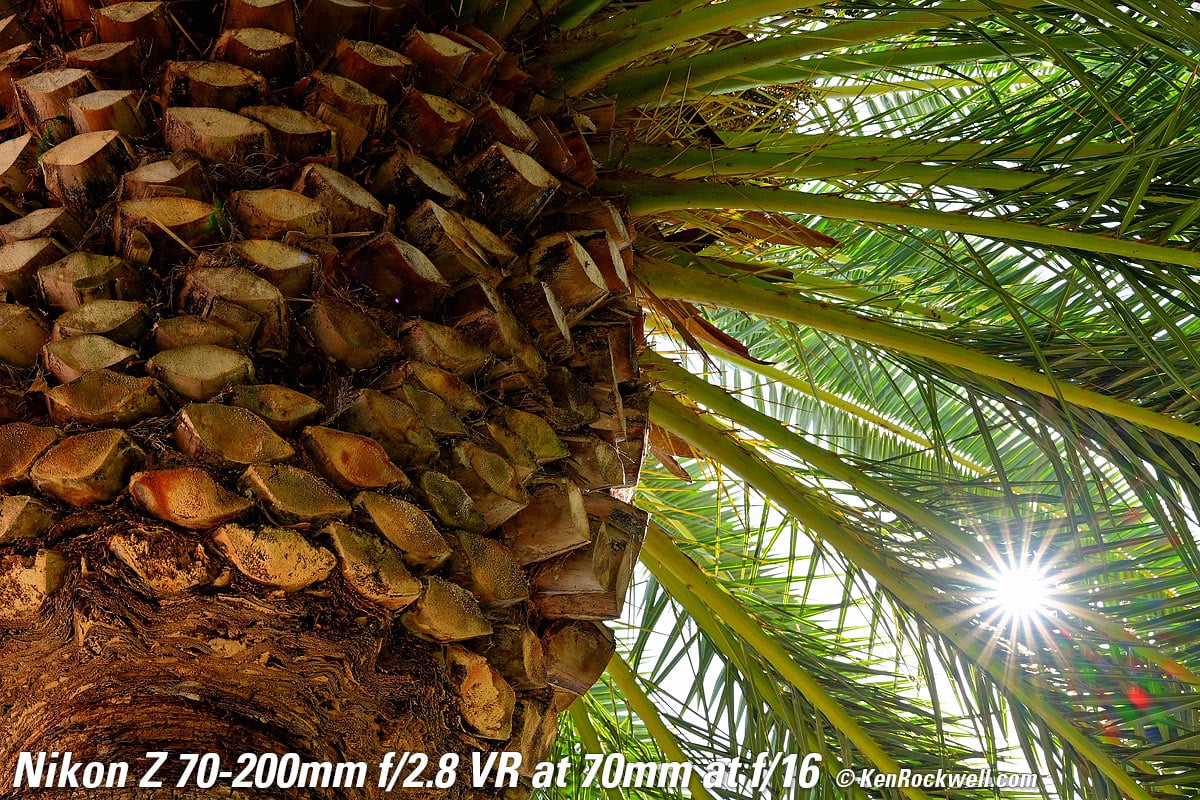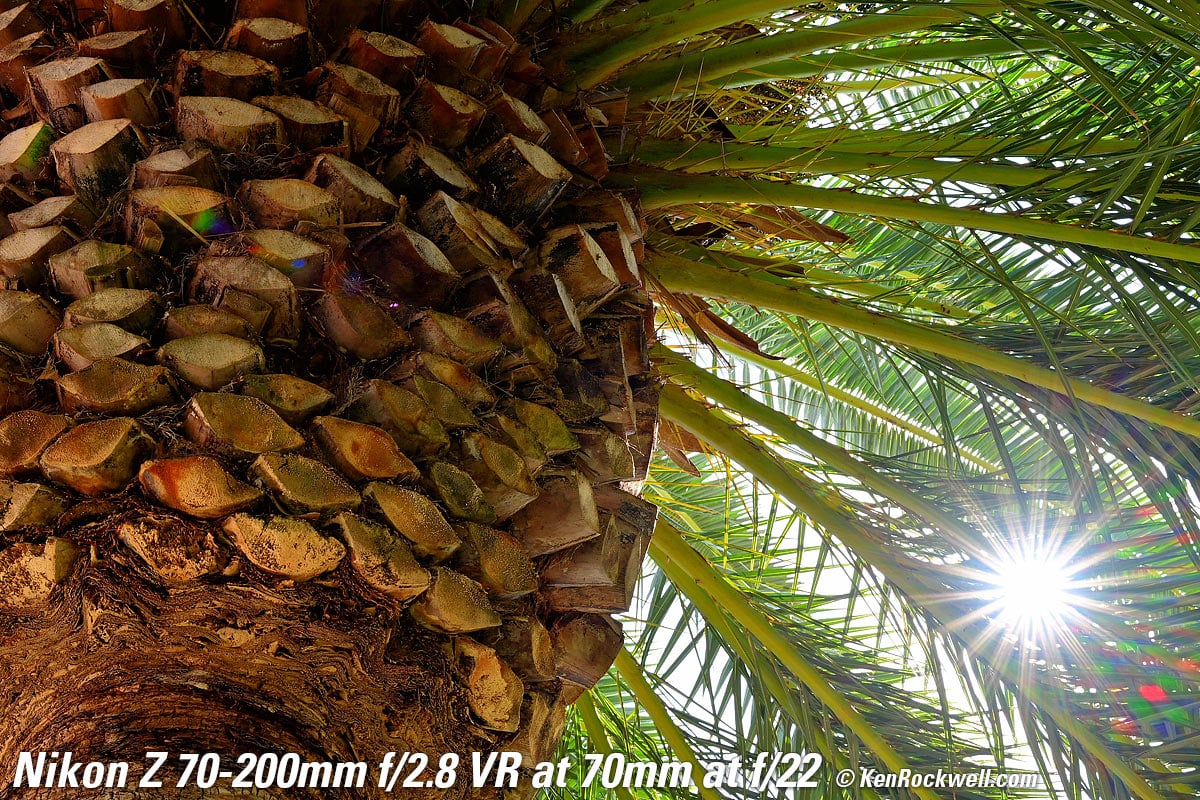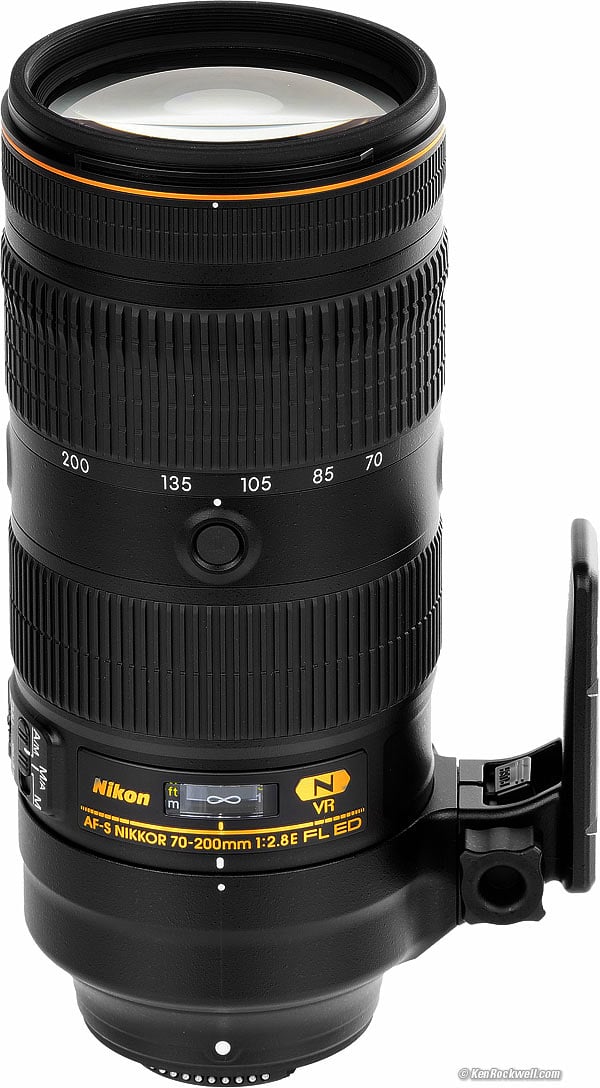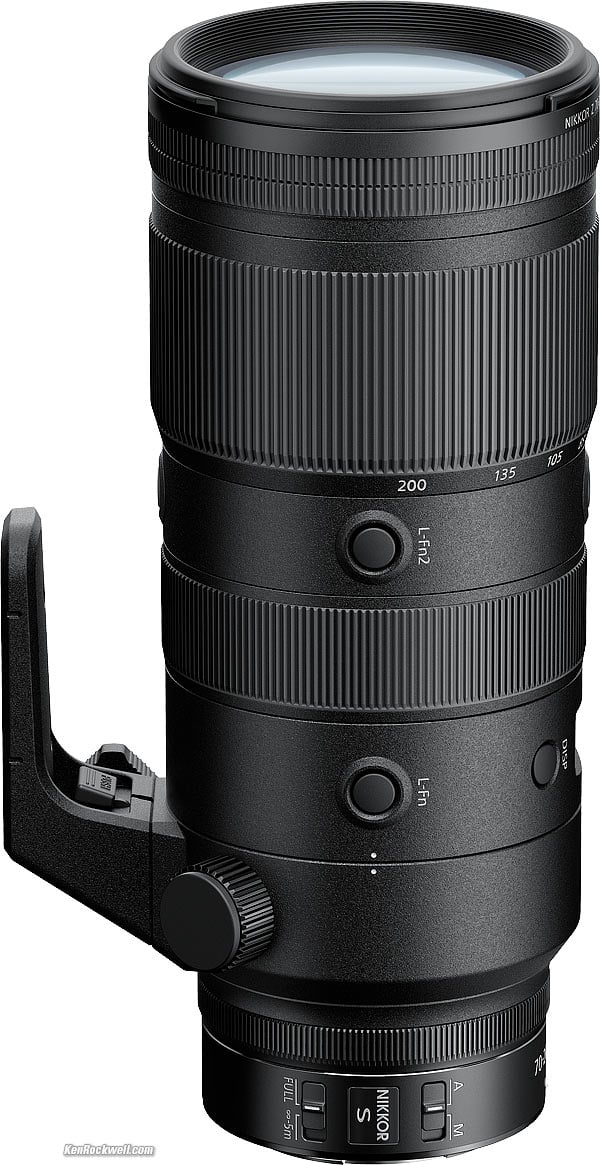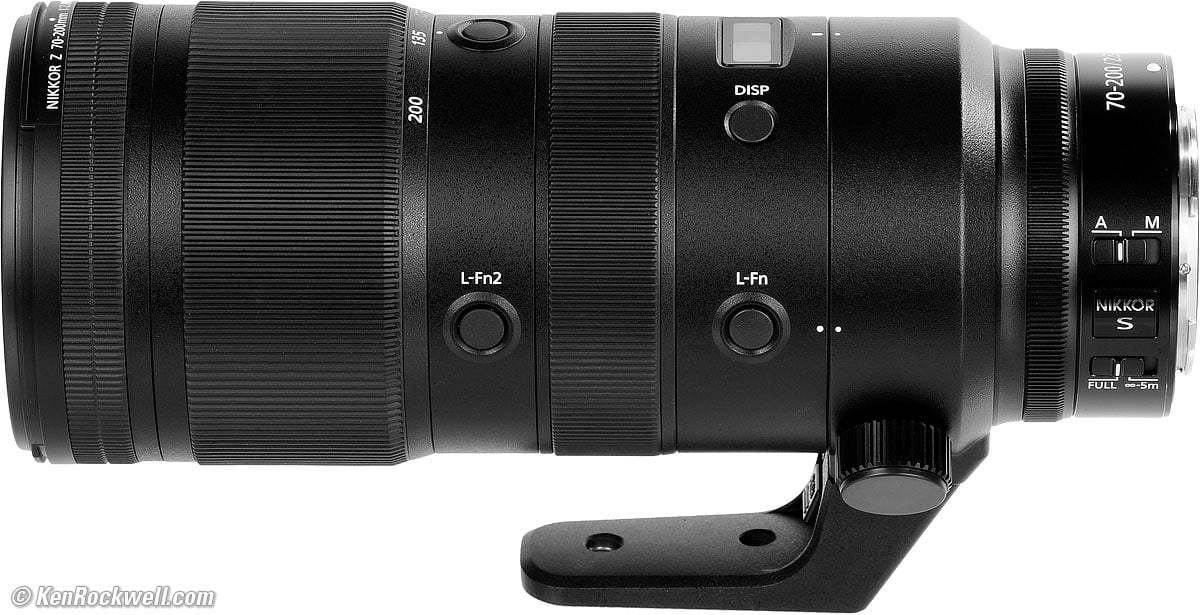Nikon Z 70‑200mm f/2.8
Full-Frame VR (2020-)
Sample Images Intro Format Compatibility
Specifications Legal USA Version Performance
Compared User's Guide Recommendations
Z9 Z8 Z7 II Z6 II Zf Z7 Z6 Z5 Z fc Z50 Z30
Z System Z Lenses All Nikon Lenses Flash
Nikon Z 70-200mm f/2.8 (metal 77mm filter thread, 50.7 oz./1,437g w/foot, 47.8 oz./1,355g without foot, 1.6'/0.5m close-focus at 70mm and 3.3'/1m close focus at 200mm, $2,397 or about $1,800 used if you know How to Win at eBay). bigger. I got mine at Adorama. I'd also get it at Amazon, at B&H, at Crutchfield or used at eBay if you know How to Win at eBay.
This 100% all-content, junk-free website's biggest source of support is when you use those or any of these links to my personally approved sources I've used myself for way over 100 combined years when you get anything, regardless of the country in which you live. Nikon does not seal its boxes in any way, so never buy at retail or any other source not on my personally approved list since you'll have no way of knowing if you're missing accessories, getting a defective, damaged, returned, non-USA, store demo or used lens — and all of my personally approved sources allow for 100% cash-back returns for at least 30 days if you don't love your new lens. I've used many of these sources since the 1970s because I can try it in my own hands and return it if I don't love it, and because they ship from secure remote warehouses where no one gets to touch your new lens before you do. Buy only from the approved sources I've used myself for decades for the best prices, service, return policies and selection.
Febuary 2024, Christmas Eve 2022 Nikon Mirrorless Mirrorless Lenses All Nikon Lenses Nikon Flash All Reviews
Nikon F AF-S 70-200mm f/2.8 VR FL (use with FTZ)
All Nikon 80-200mm and 70-200mm f/2.8 Lenses Compared
Sony vs. Nikon vs. Canon Full-Frame
Sample Images top
Sample Images Intro Format Compatibility
Specifications Legal USA Version Performance
Compared User's Guide Recommendations
More samples at Bokeh, Macro and Spherochromatism.
These are just snapshots; my real work is in my Gallery.
These are all shot hand-held as BASIC ★ JPGs; no tripods, NORMAL or FINE JPGs or RAW files were used or needed.
Yellow Hibiscus, 10:24A M, 25 September 2020. Nikon Z7, Nikon Z 70-200mm f/2.8 at 200mm at f/8 at 1/250 at Auto ISO 64, -0.7 stops exposure compensation to keep the red channel from clipping (LV 14.6), Perfectly Clear. bigger, full resolution or camera-original © JPG file.
Palm Lake, 7:27 AM, 01 October 2020. Nikon Z7, Nikon Z 70-200mm f/2.8 at 200mm wide-open at f/2.8 at 1/1,000 at Auto ISO 64 (LV 13.6), Perfectly Clear. bigger, full resolution or camera-original © JPG file.
As expected, it's ultra sharp, especially wide-open at f/2.8. Of course depth of field is limited and only some of the palms are actually in focus here at f/2.8.
Fluff Plant, 5:20 PM, 04 October 2020. Nikon Z7, Nikon Z 70-200mm f/2.8 at 200mm at f/11 at 1/50 hand-held at Auto ISO 100 (LV 12.6), Perfectly Clear. bigger, full resolution or camera-original © JPG file.
Introduction top
Sample Images Intro Format Compatibility
Specifications Legal USA Version Performance
Compared User's Guide Recommendations
|
I buy only from these approved sources. I can't vouch for ads below. |
This Nikon Z 70-200mm f/2.8 is the latest in a long line of f/2.8 80-200mm and 70-200mm telephoto zooms, of which Nikon invented the world's first back in 1978.
What's new is that this 70-200/2.8 is for Nikon's new Z series of mirrorless cameras and it focuses very closely. Like all Nikon's f/2.8 70-200mm and 80-200mm telephoto zooms, its optics are flawless.
While a mirrorless lens, this Z 70-200 2.8 is designed for optical perfection, not small size. It's actually bigger and heaver than the current AF-S 70-200mm f/2.8 VR FL DSLR lens, which also works on Z cameras with the FTZ adapter.
Just turn the focus ring at any time for instant manual-focus override.
I got my Z 70-200/2.8 at Adorama. I'd also get it at Amazon, at B&H, at Crutchfield, or used at eBay if you know How to Win at eBay.
New intro top
 Nikon's first tele zoom for full-frame Z cameras.
Nikon's first tele zoom for full-frame Z cameras.
 Ultra-close focus: 1.6'/0.5m at 70mm and 3.3'/1m 200mm, but does this by reducing the effective focal length at close distances (unchanged at infinity). Maximum macro reproduction ratio isn't much different than other lenses (1:5 or 0.2 ×), and most importantly you won't have to worry about subjects getting so close you can't shoot them. This greatly expands this lens' operational envelope to let us take more pictures under more conditions.
Ultra-close focus: 1.6'/0.5m at 70mm and 3.3'/1m 200mm, but does this by reducing the effective focal length at close distances (unchanged at infinity). Maximum macro reproduction ratio isn't much different than other lenses (1:5 or 0.2 ×), and most importantly you won't have to worry about subjects getting so close you can't shoot them. This greatly expands this lens' operational envelope to let us take more pictures under more conditions.
 Nikon's first use of an SR glass element (Short-wavelength Refractive, same as Canon's BR Blue Refractive compound) to reduce spherochromatism, also used in the 120-300mm f/2.8 introduced the same day.
Nikon's first use of an SR glass element (Short-wavelength Refractive, same as Canon's BR Blue Refractive compound) to reduce spherochromatism, also used in the 120-300mm f/2.8 introduced the same day.
 Optical VR Image Stabilizer rated 5½ stops improvement, the largest improvement yet claimed for any Nikon lens. (only gives three stops real-world improvement when actually tested.)
Optical VR Image Stabilizer rated 5½ stops improvement, the largest improvement yet claimed for any Nikon lens. (only gives three stops real-world improvement when actually tested.)
 Tiny top OLED panel can show your choice of focus distance with depth-of-field, aperture or zoom setting (panel on Z 24-70/2.8 shown; same in this lens):
Tiny top OLED panel can show your choice of focus distance with depth-of-field, aperture or zoom setting (panel on Z 24-70/2.8 shown; same in this lens):
 Cable lock socket hidden under plastic flap on tripod collar lock knob:
Cable lock socket hidden under plastic flap on tripod collar lock knob:
Cable lock socket. bigger.
Good
 Excellent optics, just like every Nikon f/2.8 telephoto since the 1970s. Telephotos have always been the easiest zooms to make ultra sharp.
Excellent optics, just like every Nikon f/2.8 telephoto since the 1970s. Telephotos have always been the easiest zooms to make ultra sharp.
 Very close focusing.
Very close focusing.
 Four + One programmable function buttons.
Four + One programmable function buttons.
 Third programmable control ring, in addition to dedicated zoom and focus rings. You may set it to aperture, exposure compensation, ISO or nothing.
Third programmable control ring, in addition to dedicated zoom and focus rings. You may set it to aperture, exposure compensation, ISO or nothing.
 Minimal focus breathing.
Minimal focus breathing.
 Weather sealed.
Weather sealed.
 Rational 77mm filter size.
Rational 77mm filter size.
Bad intro top
 Offshored to Thailand like Nikon's consumer lenses; not made domestically in Japan like every other Nikon professional 80-200/2.8 and 70-200mm/2.8.
Offshored to Thailand like Nikon's consumer lenses; not made domestically in Japan like every other Nikon professional 80-200/2.8 and 70-200mm/2.8.
Nikon Z 70-200mm f/2.8. bigger.
 Tripod collar doesn't come off; instead only the foot comes off which leaves a clunky stump and knob in your way:
Tripod collar doesn't come off; instead only the foot comes off which leaves a clunky stump and knob in your way:
Foot comes off, but ring, stump and lock knob stay on. bigger.
 A programming flaw makes the top OLED panel show "FAUTO" instead of the aperture in S or P modes; it's not smart enough to mirror the camera's selection of aperture as the camera's top display can.
A programming flaw makes the top OLED panel show "FAUTO" instead of the aperture in S or P modes; it's not smart enough to mirror the camera's selection of aperture as the camera's top display can.
 Bigger than the fully professional Nikon F 70-200mm f/2.8 VR FL.
Bigger than the fully professional Nikon F 70-200mm f/2.8 VR FL.
 Heavier than the fully professional Nikon F 70-200mm f/2.8 VR FL.
Heavier than the fully professional Nikon F 70-200mm f/2.8 VR FL.
 More expensive than the fully professional Nikon F 70-200mm f/2.8 VR FL.
More expensive than the fully professional Nikon F 70-200mm f/2.8 VR FL.
Missing intro top
 No VR Switch; have to do it in a menu or maybe program it to a control button or ring.
No VR Switch; have to do it in a menu or maybe program it to a control button or ring.
 No Arca-Swiss dovetail on the tripod foot; you'll have to buy an Arca-Swiss plate to use that system.
No Arca-Swiss dovetail on the tripod foot; you'll have to buy an Arca-Swiss plate to use that system.
 Tiny OLED panel lacks automatic brightness control (the OLED panels of the Z6 and Z7 cameras have automatic brightness control), so you won't be able to read the lens' OLED panel outdoors unless you manually increase its brightness. Once you increase the brightness so you can read it outdoors, it will be too bright indoors until you manually adjust it again. Worse, you have to press the DISP button for it to turn on and then it turns off 10 seconds later - it's not always on so it's more of an annoyance than a feature.
Tiny OLED panel lacks automatic brightness control (the OLED panels of the Z6 and Z7 cameras have automatic brightness control), so you won't be able to read the lens' OLED panel outdoors unless you manually increase its brightness. Once you increase the brightness so you can read it outdoors, it will be too bright indoors until you manually adjust it again. Worse, you have to press the DISP button for it to turn on and then it turns off 10 seconds later - it's not always on so it's more of an annoyance than a feature.
Format top
Sample Images Intro Format Compatibility
Specifications Legal USA Version Performance
Compared User's Guide Recommendations
I got my Z 70-200/2.8 at Adorama. I'd also get it at Amazon, at B&H, at Crutchfield or used at eBay if you know How to Win at eBay.
This is a full frame FX lens, and I'm reviewing it as such.
It works great on DX mirrorless, too, on which you may make the usual inferences. As of this writing, the only DX mirrorless is the Z50.
Compatibility top
Sample Images Intro Format Compatibility
Specifications Legal USA Version Performance
Compared User's Guide Recommendations
I got my Z 70-200/2.8 at Adorama. I'd also get it at Amazon, at B&H, at Crutchfield or used at eBay if you know How to Win at eBay.
Nikon Z 70-200mm f/2.8 on Nikon Z7. bigger.
This lens works only on Nikon's Z-series mirrorless cameras as shown.
It does not so much as even mount on any other camera.
Specifications top
Sample Images Intro Format Compatibility
Specifications Legal USA Version Performance
Compared User's Guide Recommendations
I got my Z 70-200/2.8 at Adorama. I'd also get it at Amazon, at B&H, at Crutchfield or used at eBay if you know How to Win at eBay.
Name specifications top
Nikon calls this the NIKKOR Z 70-200mm f/2.8 VR S:NIKKOR: Nikon's brand name for all their lenses.
Z: For Nikon's mirrorless cameras.
VR: Vibration Reduction.
S: Subliminally suggests sexual satisfaction. The "S" designation has no other purpose than subliminal seduction; Nikon and electronics and automobile and every kind of marketer have been using letters like "S" and "X" in model numbers since the 1940s for this same reason. Nikon called their first 1946 rangefinder lens mount the "S" mount, then went whole-hog to the "F" SLR mount in 1959, used "S" again when they updated their AI lenses to AI-"S" in 1983, created AF-"S" SWM lenses in 1998 and here it is again.
Also has:
AF-P: STM Stepper (Pulse) autofocus motor: silent and ultra fast.
ARNEO Coat: Magic anti-reflection coating that's especially good for use in high-speed lenses.
Aspherical: Specially curved glass elements for sharper pictures.
D: Couples distance information to the 3D Matrix Meter.
ED: Magic Extra-low Dispersion glass for reduced secondary chromatic aberration.
FL: Fluorite element(s) for sharper images in telephoto lenses.
G: Gelded; has no aperture ring.
IF: Internal focusing; nothing moves externally as focused.
Nano Crystal Coat (N): Magic anti-reflection coating that has a variable index of refraction that's far more effective against ghosts and internal reflections than traditional multicoating.
SR: Short-wavelength Refractive, a new optical material that helps reduce spherochromatism.
∅77: 77mm filter thread.
Optics specifications top
Nikon Z 70-200mm f/2.8 internal optical construction. Conventional optical glass, ED, Fluorite, SR and Aspherical elements.
21 elements in 18 groups.
6 ED extra-low dispersion element, which help reduce secondary axial chromatic aberration.
1 Fluorite element for extreme sharpness.
1 SR element to reduce spherochromatism.
2 aspherical elements for general optical supremacy.
Nikon Super Integrated multicoating (SIC), Nano and ARNEO anti-reflection coatings.
Fluorine front element coating to resist dirt and smudges.
Filters specifications top
77 mm filter thread.
Diaphragm specifications top
Nikon Z 70-200mm f/2.8. bigger.
9 rounded blades.
Electronically actuated.
Stops down to f/22.
Focal Length specifications top
70~200mm.
When used on DX cameras, it sees the same angle of view as a 105-300mm lens sees when used on an FX or 35mm camera.
See also Crop Factor.
Angle of View specifications top
34⅓º ~ 12⅓º diagonal on FX.
22⅚º ~ 8º diagonal on DX.
Autofocus specifications top
No external movement as focussed, so no air or dust is sucked in.
Focus Scale specifications top
Yes, on a tiny OLED panel.
Infinity Focus Stop specifications top
No.
Depth of Field Scale specifications top
Yes, shown on a tiny OLED panel.
Infrared Focus Index specifications top
No.
Close Focus specifications top
1.64 feet (0.5 m) at 70mm.
3.28 feet (1 m) at 200mm.
Maximum Reproduction Ratio specifications top
1:5 (0.2 ×).
Reproduction Ratio Scale specifications top
No.
Image Stabilizer specifications top
Rated 5½ stops improvement.
Caps specifications top
LC-77B front cap.
LF-N1 Z-mount rear cap.
Hood specifications top
HB-92 locking plastic bayonet hood, included:
Nikon HB-92 hood. bigger. |
Locking latch release button. bigger. |
"Case" specifications top
Nikon claims it includes a case, but it's only a CL-C3 cloth bag.
A tube sock works better.
I love my Think Tank Retrospective bags for carrying this lens with my Z system: the Z 14-30mm, this lens and my SB-400 flash.
Tripod Collar specifications top
Permanently attached, although the foot pops off.
Two reinforced ¼″ × 20 TPI sockets. bigger.
Size specifications top
3.5" ø maximum diameter × 8.7" extension from flange.
89 mm ø maximum diameter × 220 mm extension from flange.
Weight specifications top
50.7025 oz. (1,437.45g) actual measured weight with foot.
47.817 oz. (1,355.45 g) actual weight without foot.
Foot only: 2.885 oz. (81.8g).
Rated 50.8 oz (1,440 g or 3.17 pounds) with foot.
Rated 48.0 oz. (1,360 g or 3.00 pounds) without foot.
Quality specifications top
Nikon Z 70-200mm f/2.8. bigger.
Offshored to Thailand.
Announced specifications top
9:12 PM, 05 January 2020, NYC time.
Promised for specifications top
February 2020.
Available since specifications top
I got mine in September 2020.
As of October 2020 they are still very hard to find; you have to order and be patient. See also How to Get It.
Included specifications top
Lens with permanently attached tripod collar and removable foot.
LC-77B front cap.
LF-N1 Z-mount rear cap.
HB-92 Lens Hood
CL-C3 Lens "case."
Nikon's Model Number specifications top
20091.
Price, U. S. A. specifications top
Febuary 2024
$2,397 at Adorama, at Amazon, at B&H and at Crutchfield.
About $1,800 used if you know How to Win at eBay.
January 2024
$2,397 at Adorama, at Amazon, at B&H and at Crutchfield.
About $1,800 used if you know How to Win at eBay.
Christmas Eve 2022
$2,397 at Adorama, at Amazon, at B&H and at Crutchfield.
About $1,850 used if you know How to Win at eBay.
July 2021
$2,597 at Adorama, at Amazon, at B&H and at Crutchfield.
About $2,000 used if you know How to Win at eBay.
January ~ October 2020
$2,599 MSRP.
Getting a Legal USA Version top
Sample Images Intro Format Compatibility
Specifications Legal USA Version Performance
Compared User's Guide Recommendations
This section applies in the USA only.
I got my Z 70-200/2.8 at Adorama. I'd also get it at Amazon, at B&H, at Crutchfield or used at eBay if you know How to Win at eBay.
In the USA, be sure your box contains a printed card that specifically mentions NIKON USA and that the serial number on the card matches the one on your lens exactly. If the card only says NIKON INC. (not USA) or has the wrong serial number, you got ripped off with a gray market version from another country. (The serial number on the box doesn't have to match, but if it doesn't it means you bought from a shady dealer who took lenses out of boxes and then resold them as new.) This is why I never buy anyplace other than from my personally approved sources. You just can't take the chance of buying elsewhere, especially at any retail store, because non-USA versions have no warranty in the USA, and you won't even be able to get firmware or service for it — even if you're willing to pay out-of-pocket for it when you need it!
Nikon USA enforces its trademarks strictly. It's unlikely, but possible that US customs won't let your camera back in the country if you bought a gray-market version in the USA, carried it overseas, and try to bring it back in. (If you take the chance of buying one overseas, be sure you have a receipt to prove you bought it overseas and be prepared to pay duty on it.)
If a gray market version saves you $1,000 it may be worth it, but for $300 or less I wouldn't risk having no warranty or support.
Always be sure to check your box while you can still return it, or just don't buy from unapproved sources or at retail so you'll be able to have your camera serviced and get free updated firmware as needed.
I got my Z 70-200/2.8 at Adorama. I'd also get it at Amazon, at B&H, at Crutchfield or eventually used at eBay if you know How to Win at eBay.
Get yours from the same places I do and you won't have a problem, but if you take the risk of getting yours elsewhere, be sure to check everything while you still can return it. Never buy at retail because the boxes are unsealed and it's an almost certainty that a lens as exotic and desirable as this will have been taken out on a few weekend "test shoots" by the salesmen before being sold to you. Never buy retail, unless you want to pay full price for a lens dropped - and returned - by others.
Performance top
Sample Images Intro Format Compatibility
Specifications Legal USA Version Performance
Compared User's Guide Recommendations
Overall Autofocus Manual Focus Breathing Bokeh
Distortion Ergonomics OLED Display Falloff Filters
Flare & Ghosts Lateral Color Fringes
Lens Corrections Macro Mechanics Sharpness
Spherochromatism Stabilization Sunstars
I got my Z 70-200/2.8 at Adorama. I'd also get it at Amazon, at B&H, at Crutchfield or used at eBay if you know How to Win at eBay.
Overall performance top
The Nikon Z 70-200/2.8 has superb optics, but it's big, heavy and oddly also more plasticy than any other Nikon 70-200/ or 80-200/2.8 ever made.
This 70-200 is also the first Nikon f/2.8 70-200 or 80-200 ever offshored to Thailand rather than being made domestically in Japan. This tells me that that we're not really getting pro grade, even if the price is pro-grade.
The F-mount AF-S 70-200mm f/2.8 VR FL (which can be used with FTZ on Nikon's Z cameras) is built much tougher. I don't have as much confidence that this lens is as good a career investment. All the F-mount 70-200 and 80-200/2.8s are pro lenses that will provide decades of use. I won't be able to vouch for this Thai lens until time shows us that it will hold up.
Autofocus performance top
Autofocus is pokey, but this is also a factor of my Nikon Z7, which wins no prizes for autofocus.
It's nowhere near as fast as the F-Mount AF-S 70-200mm f/2.8 VR FL is on a DSLR.
Manual Focus performance top
Manual focus is excellent.
Just grab the middle focus ring at any time for instant manual-focus override.
Focus Breathing performance top
Focus breathing is the image changing size as focused in and out. It's important to cinematographers that the image not breathe because it looks funny if the image changes size as focus gets pulled back and forth between actors. If the lens does this, the image "breathes" by growing and contracting slightly as the dialog goes back and forth.
Overall in most practical uses there is no obvious breathing. This is excellent.
If you look way too hard at f/22 and cover the entire focus range, the image from the 70-200mm gets slightly smaller at 70mm and 85mm as focussed more closely.
There is no breathing at 105mm.
The image from the 70-200mm gets slightly larger at 135mm and 200mm as focussed more closely.
Bokeh performance top
Bokeh, the feel, character or quality of out-of-focus areas as opposed to how far out of focus they are, is neutral. Blur circles are just circles.
Since this lens is reasonably fast and long, blur circles become large and backgrounds are very far out of focus at larger apertures and longer zoom settings.
Here are photos from headshot distance wide-open.
Click either for the camera-original © files:
Made-in-U. S. A. Davis 6250 weather station, 25 September 2020. Nikon Z7 and Nikon Z 70-200mm f/2.8 VR at 1/1,600 and 1/2,000 at Auto ISO 64.
Click either for the camera-original © files.
As always, if you want to throw the background as far out of focus as possible, shoot at 200mm at f/2.8 and get as close as possible.
Distortion performance top
The Nikon Z 70-200mm has no visible distortion as shot on Nikon's Z cameras because they always automatically correct for it in JPGs.
Beware: if you shoot raw and then open these files with non-Nikon software, it's very likely that you will have no distortion correction and will see distortion. I haven't tried; I don't shoot raw.
In-camera correction is perfect. If you turn off correction, there is no distortion at 70mm and strong pincushion distortion from 105mm to 200mm.
Use these corrections in Photoshop's lens correction filter for uncorrected images.
These aren't facts or specifications, they are the results of my research that requires hours of photography and calculations on the resulting data.
On Full-Frame at 30' (10m) on Z7 |
Correction factor with corrected images |
Correction factor with uncorrected images |
70mm |
±0.00 | ±0.00 |
85mm |
±0.00 | -0.50 |
105mm |
±0.00 | -2.00 |
135mm |
±0.00 | -3.00 |
200mm |
±0.00 | -3.00 |
© 2020 KenRockwell.com. All rights reserved.
Ergonomics performance top
The narrow front rubber ring is just trim; use it as a grip for hand-holding. it doesn't turn or do anything else.
The big front zoom ring is great; it's easy to zoom with thumb and forefinger, or with just your middle finger if you're holding the lens from the very front ring.
There are four L-Fn2 buttons behind the zoom ring. You can program them for various functions like Focus Lock in your camera's MENU system. All four will have the same function. There are four so you always have one at your fingertips regardless of camera position.
By default the rubberized focus ring is always active for instant manual focus override. It's entirely electronic; it's not connected to anything mechanically.
The focus ring is heavily damped, probably to keep us from flicking it faster than the encoder can handle.
There's another L-Fn button near the DISP button. You may program this in your camera's menu system.
The knurled ring near the rear mount is another programmable control ring, in addition to the dedicated manual focus and zoom rings.
The small OLED display on the top is described next:
OLED Display (same as shown on Z 24-70/2.8) performance top
The tiny panel shows "NIKKOR" for a few seconds when you turn on the camera, and then defaults to show the distance in meters. How to change the brightness or to select feet.
If you are in M or A modes and have selected an aperture manually, the distance display will also show a bar for the depth-of-field which changes with the aperture, zoom setting and even focus distance (panel from Z 24-70/2.8 shown; same thing in this lens):
Splash display on power-ON. bigger. |
Distance display. bigger. |
Distance w/depth-of-field bar. bigger. |
| This is what you get for two seconds when you turn on the camera. You don't get anything when the camera wakes from sleep. | Distance is the default display. You can change it to feet, but can't get both at the same time. | You also get this depth-of-field indicator if you're in A or M modes. You won't get it in P or S modes. |
Press the DISP button to change it to Focal Length or Aperture. Sadly a programming defect makes it show FAUTO instead of the aperture in S or P modes; it's not smart enough to mirror the camera's selection of aperture as the camera's top display can (panel from Z 24-70/2.8 shown; same thing in this lens):
Focal length. bigger. |
Aperture. bigger. |
Aperture in P or S modes. bigger. |
| This reads with one decimal place in 0.5 mm from 24~35mm (26.0mm or 31.5mm for example), and in whole millimeters (47mm for example) from 35~70mm. | This reads the manually set f/stop, but only in M or A exposure modes. | The lens does not display the aperture in P or S modes; this is a meaningless display. Look at your camera's top OLED to get the answer instead. |
That's the good news. The bad news is that there's no automatic brightness control (as the OLED panels of the Z6 and Z7 have), so you won't be able to read the lens' OLED panel outdoors unless you manually increase its brightness. Once you increase the brightness so you can read it outdoors, it probably will be too bright indoors until you manually adjust it again.
Don't worry, because you'll almost never see this panel light up anyway. You have to press the DISP button for it to turn on, and then it turns off 10 seconds later, or 10 seconds after you last did anything to turn it on like change a setting.
It's not always on so it's more of a nuisance than a feature. Old people will remember red LED digital watches from the 1970s that quickly were replaced with today's LCD digital watches because no one wanted to have to use their other hand to press a button just to read the time. (Apple Watches have solved this problem.)
The distance displays only show a sliding distance scale with no tick marks. There is no digital distance display as there is for focal length. It won't show 4.85 feet or 8.3 meters, unless you know how to interpolate yourself.
You can turn off this display if you prefer for night for covert use.
Falloff performance top
Falloff on full-frame is invisible with the default setting of Vignette Control NORMAL.
I've greatly exaggerated the falloff by shooting a gray field and placing these on a gray background; it will not look this bad in actual photos of real things:
Nikon Z 70-200mm f/2.8 Falloff on full frame, Vignette Control NORMAL:
© 2020 KenRockwell.com. All rights reserved. |
If you go out of your way to turn Vignette Control OFF, here's what you get:
Nikon Z 70-200mm f/2.8 Falloff on full frame, Vignette Control OFF:
© 2020 KenRockwell.com. All rights reserved. |
Filters, use with performance top
There's no need for thin filters. I can stack at least six regular 77mm filters without vignetting at any distance or aperture.
If I stack seventeen 77mm filters, I get no vignetting at 135mm and longer.
This is excellent.
Go ahead and use your standard rotating polarizer and grad filters and pile-on as may as you like.
Flare & Ghosts performance top
There aren't any ghosts or flare worth worrying about.
Unique to this lens are special rear light absorbers. Look into the back of the lens, and you'll see very deep flutes and cuts into the rear black light-absorbing cylinder that catch stray light and ensure it doesn't reflect back to the image plane.
See examples at Sunstars.
Lateral Color Fringes performance top
Nikon Z cameras all correct for this automatically, and this correction can't be turned off, so there are no fringes shot as JPG.
If you shoot raw and then create images from this raw data using other than Nikon software, it's entirely probable that your particular software won't correct for this, and you could then see color fringes.
Lens Corrections performance top
Nikon's Z cameras always correct for lateral color fringes (chromatic aberration). This has been part of Nikon's secret sauce since 2007 and never appears in any menu.
Other cameras may be slightly different, but the Z6 and Z7 correct for distortion, diffraction and falloff (Vignette control).
Distortion, diffraction and falloff (vignette control) correction are all ON by default.
You may turn diffraction and distortion correction ON or OFF.
You may set falloff ("Vignette control") correction to OFF, LOW, NORMAL (default), or HIGH.
Macro Performance performance top
It gets reasonably close, and it's super-sharp, even wide-open at f/2.8. Bravo!
Casio G-Shock Solar Atomic Watch at close-focus distance at f/2.8 at 200mm, 25 September 2020. Nikon Z7 at 1/6,400 at Auto ISO 64. bigger or camera-original © file.
1,200 × 900 pixel (6.8× magnification) crop from above. bigger or camera-original © file.
If this 1,200 × 900 pixel crop is about 3" (7.5cm) wide on your screen, the complete image would print at a large 14 × 21″ (35 × 55 cm) at this same high magnification.
If this 1,200 × 900 pixel crop is about 6" (15cm) wide on your screen, the complete image would print at a huge 27½ × 41¼″ (70 × 105 cm) at this same high magnification.
If this 1,200 × 900 pixel crop is about 12" (30cm) wide on your screen, the complete image would print at a mammoth 55 × 82½″ (1.4 × 2.1 meters) at this same extremely high magnification!
Mechanical Quality performance top
It's not 1982 anymore, when Nikon's f/2.8 teles amazed the world and were all metal and made in Japan. Even the current F-mount 70-200mm f/2.8E FL is all-metal, made in Japan and sports a solid 14-karat gold band to signify the use of ED glass— but not this Z lens. This Z lens is mostly plastic on the outside and offshored to Thailand like Nikon's other consumer-grade lenses.
This is Nikon's first f/2.8 telephoto zoom not to have a solid 14-karat gold band signifying ED glass.
Nikon Z 70-200mm f/2.8. bigger.
Finish
Black plastic.
Hood
Plastic bayonet with lock.
Front Bumper
Rubber.
Filter Threads
Metal.
Hood Bayonet Mount
Plastic.
Gold ED Band
NONE.
Front Barrel Exterior
Plastic.
Zoom Ring
Rubber-covered plastic.
Mid Barrel 1 Exterior
Section with four L-Fn2 buttons: plastic.
Focus Ring
Rubber-covered plastic.
Mid Barrel 2 Exterior
Section with OLED display and L-Fn button: plastic.
Tripod Collar and Foot
Metal.
Mid Barrel 3 Exterior
Thin section just behind tripod collar: plastic.
Third thin rear control ring
Metal.
Rear Barrel Exterior
Thin metal vanity veneer.
Slide Switches
Plastic.
Identity
Printed around top of barrel.
Also briefly engraved on top of rear barrel.
Internals
Seem like all metal!
Dust Gasket at Mount
Yes.
Mount
Dull chromed metal.
Markings
Mostly molded as engraved and filled with paint.
Serial Number
Laser engraved on bottom of barrel near mount.
Date Code
None found.
Noises When Shaken
Very mild clunking.
Made in
Made in Thailand.
Sharpness performance top
Lens sharpness has nothing to do with picture sharpness; every lens made in the past 100 years is more than sharp enough to make super-sharp pictures if you know what you're doing. The only limitation to picture sharpness is your skill as a photographer. It's the least talented who spend the most time worrying about lens sharpness and blame crummy pictures on their equipment rather than themselves. Skilled photographers make great images with whatever camera is in their hands; I've made some of my best images of all time with an irreparably broken camera! Most pixels are thrown away before you see them, but camera makers don't want you to know that.
If you're not getting ultra-sharp pictures with this, be sure not to shoot at f/11 or smaller where all lenses are softer due to diffraction, always shoot at ISO 100 or below because cameras become softer at ISO 200 and above, avoid shooting across long distances over land which can lead to atmospheric heat shimmer, be sure everything is in perfect focus, set your camera's sharpening as you want it (I set mine to the maximum) and be sure nothing is moving, either camera or subject. If you want to ensure a soft image with any lens, shoot at f/16 at ISO 1,600 at default sharpening in daylight of subjects at differing distances in the same image.
Just like every Nikon f/2.8 tele since the 1970s, this lens is ultra sharp corner-to-corner at every aperture. Its MTF is actually rated better than the Nikon F AF-S 70-200mm f/2.8 VR FL for DSLRs, but in real-world use you'll never see a difference; all Nikon's f/2.8 tele zooms are ultra-sharp. Anyone who thinks he sees a difference is seeing flaws in his test and comparison procedure; these lenses are essentially optically perfect — as you should expect from a $2,600 Nikon lens:
Spherochromatism performance top
Spherochromatism, also called secondary spherical chromatic aberration or "color bokeh," is an advanced form of spherical and chromatic aberration in a different dimension than lateral chromatic aberration. It happens mostly in fast normal and tele lenses when spherical aberration at the ends of the color spectrum are corrected differently than in the middle of the spectrum. Spherochromatism can cause colored fringes on out-of-focus highlights, usually seen as green fringes on backgrounds and magenta fringes on foregrounds. Spherochromatism is common in fast lenses of moderate focal length when shooting contrasty items at full aperture. It goes away as stopped down.
This 70-200 has nearly no spherochromatism, which is superb performance:
Mondaine A132.30348.11SBB at close-focus distance at 200mm at f/2.8, 25 September 2020. Nikon Z7 at 1/2,000 at Auto ISO 64. bigger or camera-original © file.
1,200 × 900 pixel (6.8× magnification) crop from above. bigger or camera-original © file.
If this 1,200 × 900 pixel crop is about 3" (7.5cm) wide on your screen, the complete image would print at a large 14 × 21″ (35 × 55 cm) at this same high magnification.
If this 1,200 × 900 pixel crop is about 6" (15cm) wide on your screen, the complete image would print at a huge 27½ × 41¼″ (70 × 105 cm) at this same high magnification.
If this 1,200 × 900 pixel crop is about 12" (30cm) wide on your screen, the complete image would print at a mammoth 55 × 82½″ (1.4 × 2.1 meters) at this same extremely high magnification!
Image Stabilization performance top
Optical Image Stabilization (OIS, IS or VR (Vibration Reduction)) is good, but not extraordinary. I see three stops of real-world improvement and get perfectly-sharp shots almost all the time at 1/15 at all focal lengths.
"Percent Perfectly Sharp Shots" are the percentage of frames with 100% perfect tripod-equivalent sharpness I get when I'm shooting hand-held while free-standing with no support or bracing. Hand tremor is a random occurrence, so at marginal speeds some frames will be perfectly sharp while others will be in various stages of blur — all at the same shutter speed. This rates what percentage of shots are perfectly sharp, not how sharp are all the frames:
At 70mm on Nikon Z7 with firmware 3.11:
| % Perfectly Sharp Shots | 1 |
1/2 |
1/4 |
1/8 |
1/15 |
1/30 |
1/60 |
1/125 |
1/250 |
| Stabilization ON | 0 |
5 |
17 |
33 |
83 |
100 |
100 |
100 |
100 |
| Stabilization OFF | 0 |
0 |
0 |
0 |
10 |
0 |
33 |
67 |
100 |
I see a three-stop real-world improvement.
At 200mm on Nikon Z7 with firmware 3.11:
| % Perfectly Sharp Shots | 1 |
1/2 |
1/4 |
1/8 |
1/15 |
1/30 |
1/60 |
1/125 |
1/250 |
| Stabilization ON | 0 |
0 |
17 |
20 |
100 |
100 |
100 |
100 |
100 |
| Stabilization OFF | 0 |
0 |
0 |
0 |
0 |
0 |
0 |
70 |
70 |
I see a three-stop real-world improvement.
Sunstars performance top
With a 9-bladed rounded diaphragm, I get 18-pointed sunstars on brilliant points of light only at the smallest apertures.
Ignore the the vertical smear at f/2.8 and f/4, this is a sensor artifact called interline transfer smear and not a lens defect.
Likewise ignore the crazy rainbow effects at smaller apertures; these are different sensor artifacts caused by taking a picture directly of the sun and exposing for the dark underside of the palm tree.
Click any to enlarge:
Teleconverters performance top
This works with the Nikon Z TC-1.4× teleconverter and Nikon Z TC-2× teleconverter, and works very well with them.
Tripod Collar performance top
The tripod collar is inferior. It uses the old removable-foot design which works great with the foot attached, but leaves a nasty stump, collar and lock knob on your lens when you remove the foot for hand-holding:
Foot comes off, but the collar, stump and lock knob stays on. bigger.
Better designs, like Canon's RF 70-200/2.8L, have collars which remove completely and make the lens much better for hand-holding. This Z 70-200 is a turd for hand-holding.
There are no 90° clicks; just engraved indices at 90º on both collar and lens.
The foot lacks an Arca-Swiss dovetail, so you'll have to buy an Arca-Swiss plate to use that system:
Two reinforced ¼″ × 20 TPI sockets. bigger.
Compared top
Sample Images Intro Format Compatibility
Specifications Legal USA Version Performance
Compared User's Guide Recommendations
See also All Nikon 80-200mm and 70-200mm f/2.8 Lenses Compared.
I got my Z 70-200/2.8 at Adorama. I'd also get it at Amazon, at B&H, at Crutchfield or used at eBay if you know How to Win at eBay.
(roughly to scale) |
|||
| Introduced | 2016 August |
2020 January |
2019 October |
| Speed | f/2.8 |
f/2.8 |
f/2.8 |
| VR/IS rated | 4 stops |
5½ stops |
5 stops |
| VR/IS actually performs | |||
| Close-focus | 3.6' (1.1 m) at 70mm 3.6' (1.1 m) at 200mm |
1.6' (0.5m) at 70mm 3.3' (1m) at 200mm |
2.3' (0.7m) at 70mm 2.3' (0.7m) at 200mm |
| Max. Repro. Ratio | 1:4.76 0.21 × |
1:5 0.2 × |
1:4.3 0.23 × |
A/M and M/A modes |
Yes |
No, just one AF mode. |
No, just one AF mode. |
| VR Switches | Yes |
No |
Yes |
| Third programmable control ring | No |
Yes |
Yes |
| Focus Limiter | Yes |
Yes |
Yes |
| Control Buttons (AF-L etc.) | Four |
Four + One |
none |
| Front bumper | Yes |
Yes |
none |
| Filter thrreads | 77mm, metal |
77mm, metal |
77mm, plastic |
| MTF, 70mm (click to enlarge) | |||
| MTF, 200mm (click to enlarge) | |||
| Outside Diameter | 3.5" 88.5 mm |
3.5" 89 mm |
3.5" 90 mm |
| Length (from flange) | 7.9" 202 mm |
8.7" 220 mm |
5¾" 146 mm |
| Weight, w/foot & collar* | 50.3 oz. 1,425g |
50.7 oz. 1,437g |
41.9 oz. 1,187 g |
| Quality | Made in JAPAN |
offshored to Thailand |
Made in JAPAN |
| Price, 01/2020 | |||
| Price, 10/2020 | |||
| Price, 12/2022 |
* Actual measured
User's Guide top
Sample Images Intro Format Compatibility
Specifications Legal USA Version Performance
Compared User's Guide Recommendations
I got my Z 70-200/2.8 at Adorama. I'd also get it at Amazon, at B&H, at Crutchfield or used at eBay if you know How to Win at eBay.
Nikon Z 70-200mm f/2.8. bigger.
I'd get my Z 70-200/2.8 at Adorama, at Amazon, at B&H, at Crutchfield or eventually used at eBay if you know How to Win at eBay.
OLED Panel & DISP button
Hold DISP a few seconds until it blinks to set. Tap DISP again to adjust either distance units (feet/meters) or brightness. Turn the rear control ring to adjust either setting.
Hold DISP a few seconds again to return to normal operation.
To turn off the OLED, set its brightness level to OFF.
L-Fn2 buttons
The function of the L-Fn2 buttons around the front of the lens is programmed in your camera at MENU > CUSTOM SETTING MENU (pencil icon) > f2 Custom control assignment > click down to find the L-Fn2 button > select your function > OK.
L-Fn button
The function of the rear L-fn button is programmed in your camera at MENU > CUSTOM SETTING MENU (pencil icon) > f2 Custom control assignment > click down to find the L-Fn button > select your function > OK.
Program the thin rear control ring
Program the rear control ring in your camera at MENU > CUSTOM SETTING MENU (pencil icon) > f2 Custom control assignment > click down to find the "Lens control ring" at bottom > OK > select your function (aperture, exposure compensation, ISO or nothing) > OK.
Sadly at its default setting of Aperture it's ignored in S or P exposure modes, and in Exposure Compensation it responds too quickly to allow proper settings.
A - M Switch
A: Auto Focus. You have instant manual focus override by turning the focus ring at any time.
M: Manual Focus only.
Full / ∞-5m Switch
This is a focus limiter.
Leave it in FULL.
The ∞-5m position prevents the lens from trying to autofocus closer than about 5 meters (16 feet). Use this setting only if you're having a problem with the lens attempting to focus on irrelevant close items, or if for some reason the lens is "hunting" from near to far while looking for distant subjects.
Recommendations top
Sample Images Intro Format Compatibility
Specifications Legal USA Version Performance
Compared User's Guide Recommendations
I got my Z 70-200/2.8 at Adorama. I'd also get it at Amazon, at B&H, at Crutchfield or used at eBay if you know How to Win at eBay.
This is an extremely popular lens, and for good reason: it's ultrasharp, and the only telephoto zoom native to Nikon's Z cameras. It's big and heavy and expensive, and offers stunning performance, just as every 80-200 or 70-200mm f/2.8 Nikon zoom has always offered.
Oddly this lens isn't smaller or lighter than the DSLR lenses.
If you already own the superb F-mount AF-S 70-200mm f/2.8 VR FL or other similar Nikon AF-S lens, just use the FTZ adapter and there's no need to buy this lens. You need an AF-S lens for autofocus on the FTZ; older AF and AF-D versions will not autofocus on the FTZ.
I use a clear (UV) protective filter instead of a cap so I'm always ready to shoot instantly. I only use a cap when I throw this in a bag with other gear without padding — which is never. The UV filter never gets in the way, and never gets lost, either.
The best protective filter is the 77mm Hoya multicoated HD3 UV which uses hardened glass and repels dirt and fingerprints.
For less money, the B+W 77mm 010 is an excellent filter, as is the multicoated version and the basic multicoated Hoya filters or the 77mm Nikon Clear (NC - UV), but the Hoya HD3 is the toughest and the best.
Filters last a lifetime, so you may as well get the best. The Hoya HD3 stays cleaner than the others since it repels oil and dirt, and will outlast this lens.
All these filters are just as sharp and take the same pictures, the difference is how much abuse they'll take and stay clean and stay in one piece.
I got my Z 70-200/2.8 at Adorama. I'd also get it at Amazon, at B&H, at Crutchfield or used at eBay if you know How to Win at eBay.
This 100% all-content website's biggest source of support is when you use those or any of these links to approved sources when you get anything, regardless of the country in which you live. Nikon does not seal its boxes in any way, so never buy at retail or any other source not on my personally approved list since you'll have no way of knowing if you're missing accessories, getting a defective, damaged, returned, non-USA, store demo or used lens. I use the stores I do because they ship from secure remote warehouses where no one gets to touch your new camera before you do. Buy only from the approved sources I use myself for the best prices, service, return policies and selection.
Thanks for helping me help you!
Ken, Mrs. Rockwell, Ryan and Katie.
© Ken Rockwell. All rights reserved. Tous droits réservés. Alle Rechte vorbehalten.
Help Me Help You
I support my growing family through this website, as crazy as it might seem.
The biggest help is when you use any of these links when you get anything. It costs you nothing, and is this site's, and thus my family's, biggest source of support. These places always have the best prices and service, which is why I've used them since before this website existed. I recommend them all personally.
If you find this page as helpful as a book you might have had to buy or a workshop you may have had to take, feel free to help me continue helping everyone.
If you've gotten your gear through one of my links or helped otherwise, you're family. It's great people like you who allow me to keep adding to this site full-time. Thanks!
If you haven't helped yet, please do, and consider helping me with a gift of $5.00.
As this page is copyrighted and formally registered, it is unlawful to make copies, especially in the form of printouts for personal use. If you wish to make a printout for personal use, you are granted one-time permission only if you PayPal me $5.00 per printout or part thereof. Thank you!
Thanks for reading!
Mr. & Mrs. Ken Rockwell, Ryan and Katie.
